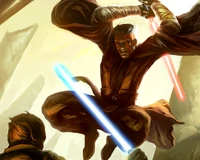| | |
A lightsaber—any weapon—only achieves worth in how it is wielded—in the effort, the struggle of one who holds it.Kreia
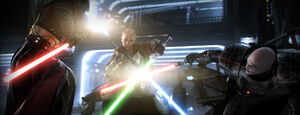
Lightsaber combat, also known as Jedi combat, referred to several schools of martial arts specialized in, though not limited to, fighting with a lightsaber. Such fighting forms were required to compensate for or take advantage of the unique attributes of lightsabers, notably the odd balance of the weapon, all of the weight being in the hilt, and the omni-directional cutting edge. The most prominent lightsaber-oriented combat styles were the seven forms of the Jedi Order, though other organizations were known to have developed their own styles and methods, an example being the Sith-developed Dun Möch technique.
The various combat forms owed their unique focuses and methods to the eras in which they were created, as they were oftentimes developed to answer a new generation of weapons technology. For example, the dueling-centric Makashi form was created during a time when Dark Jedi and rogue Force-sensitives ran rampant through the galaxy, and lightsaber duels became a common occurrence, whereas Soresu was developed when such confrontations were rare, and Jedi were more likely to confront blaster-wielding opponents and gunslingers rather than lightsaber duelists.
Overview
These weapons are not playthings. A lightsaber is a dangerous and destructive instrument, a powerful blade that can strike down an opponent—or a friend, if you're not careful.Luke Skywalker to his students
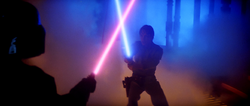
Throughout the millennia since the lightsaber's creation, the art of dueling with them developed into seven "classic" forms and numerous other styles. It was difficult to master for a number of reasons, one of them being that all of the weight a lightsaber had was in its hilt. It had been said that only a Force-sensitive individual could completely master lightsaber combat, though there have been some great non-force sensitive duelists, such as Pre Vizsla, or General Grievous. All seven traditional lightsaber forms included the same basic techniques as ancient sword-fighting styles, such as defensive postures, overhand strikes, parries, and counters.[3] A riposte was a technique where the user struck an opponent after deflecting or blocking an attack.[4]
The lightsaber was a very versatile weapon, owing to its unique lightness and omni-directional cutting ability. It could be wielded one-handed or with both hands. The Jedi were trained to use the Force as a conduit between the wielder and the weapon. Through this bond in the Force, the blade became an extension of their being; it moved with instinct as though it were a part of the body. The Jedi's attunement to the Force accounted for the almost superhuman agility and reflex illustrated in the use of the lightsaber. Early in the weapon's history, when the Sith were numerous, the art of lightsaber dueling flourished. In later periods though, only rarely would Jedi face an adversary with a weapon capable of repelling a lightsaber.[3]
Although the blade was weightless, two-handed slashes were the most common movement. This was because momentum was still needed to cut through solid objects, as solid objects were repelled by the blade arc until they were changed to gas or plasma. Therefore, momentum was required to counteract the initial repelling force. The stronger the swing, the faster and easier the blade would cut. If little force was applied to the swing, the repelling force of the blade arc would leave shallow cuts. When two lightsaber blades came in contact with each other, the two repelling forces made the blade appear to be solid. Also, the field that caused the energy to arc back into the hilt caused some gyroscopic effects. While technically weightless, the blade still had some resistance to changes in motion. The slight gyroscopic effects were easily controlled by a trained Force user, but could become problematic for the untrained.[5]
History
Early developments
If you were to face an ancient Sith lord in combat, you would learn that we are as children playing with toys compared to the prowess of the old masters.Kreia
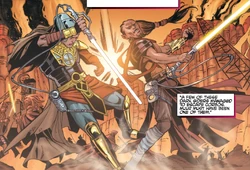
When lightsaber technology was developed to the point where they became a viable weapon, becoming the standard weapon of the Jedi Order by 7000 BBY, a combat form that accounted for the abilities and weaknesses of the weapon was required, even though it shared many principles and techniques with fencing.[6] Form I, Shii-Cho, was a highly simplified style, based on age-old fencing principles, and defining the types of attacks, parries, body zones and practice drills that could be utilized with the lightsaber. When Darksiders and fallen Jedi began to arise, lightsaber duels became an almost routine activity, and Shii-Cho was simply not up for the task, as it didn't address lightsaber-to-lightsaber combat. This necessitated the development of Form II, Makashi, a precise and efficient fighting form geared towards lightsaber dueling. This style's prevalence during this era produced many of the greatest dueling masters the galaxy had ever seen, a notable example being Tulak Hord, one of the early Sith Lords.[7][3]
Makashi was eventually rendered partially obsolete due to the increased distribution and common usage of blasters and other ranged energy weapons. Due to this, the third form, Soresu, was created. An extrapolation and development of Shii-Cho blast-deflect training, Soresu emphasized defensive coverage, characterized by tight and efficient movements. A true Form III master was considered invincible by many. However, the style was not without its detractors, who criticized its focus on defense at the expense of offense. As an answer to the weaknesses of Soresu, Ataru (form IV) and Shien (form V) were developed side by side.[8] Both were highly aggressive combat forms, the former focusing on speed and agility, the latter on strength and attack moves. Notably, Shien exploited the lightsaber's ability to deflect blaster bolts by deliberately deflecting shots towards opponents. Later, a new, more advanced Form V variant known as Djem So was developed, focused on aggressive lightsaber dueling.[7][9]
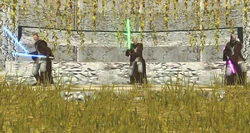
While forms IV and V proved highly effective, many more conservative Jedi were put off by their aggressive focuses, and set to work creating a form that balanced all the other focuses with overall moderation, in better keeping with Jedi philosophy.[10] The result was the sixth form, Niman.[3] Developed from the Jar'Kai dual-blade combat style, Niman was a gateway to fantastic lightsaber skill without a focus on power or aggression and became known as the "diplomat's form", though it would ironically become the favored style of the fallen Jedi-turned-Sith Lord Exar Kun, a masterful lightsaber duelist. Due to his obvious skill, Kun came to consider himself the greatest duelist in the galaxy, though he ultimately met his match in the Djem So specialist Ulic Qel-Droma.[11][12] Kun would go on to defeat Vodo-Siosk Baas, the Jedi Battlemaster of the day, and wield one of the earliest saberstaffs, creating the weapon from schematics provided by a Sith holocron.[7]
By the time of the First Jedi Purge, Juyo (form VII) had been created. An advanced and extremely aggressive form, Juyo required high-level mastery of multiple forms to be studied, as it cut perilously close to Sith intensity of focus on combat ability.[3] Specifically, Juyo drew on the agile footwork of Makashi, the tight, aggressive motions of Shien, and the fluid style of Niman. Masters of the form were loath to teach it to those with proven recklessness, and the rarity of practitioners left it in a state of only partial development for almost a thousand years after the Army of Light disbanded with the Ruusan Reforms. Four of the only known practitioners alive following the First Jedi Purge were Jedi Masters Vrook Lamar, Zez-Kai Ell, Kavar and Atris.[1][13]
Practice and Training during the Sith Resurgence
I know combat forms you've never heard of. I was trained by species you've never seen. I'm more than skilled enough to kill an unconscious man."
"But now I have your measure.Jerbhen Hulis and Teneb Kel
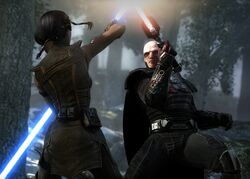
With the advent of the Great Galactic War, and the re-emergence of the old Sith Empire, the Jedi were once again in widespread confrontation with their bitter enemy. During the interim, the Sith Lords retained full access to the traditional forms, and they were in use within the Empire as early as the Jedi Civil War, with such notables as the Emperor's Wrath Scourge studying Forms VII, IV, and III.[15] There is little doubt the Sith also used the time to develop their own combat styles, although there are few records indicating clearly what they were. This was matched by the Jedi with their development of Juyo-Kos, a refinement of the already lethal Juyo to meet the demands of these dangerous times, which saw frequent and brutal engagements between Jedi and Sith. This point of view is supported by comments from Jerbhen Hulis during his brief duel with Teneb Kel.[14] Notable duelists during this period include Jaric Kaedan, a master of the aforementioned Form VII variant,[16] and Orgus Din, who attained his advanced skill-level through endless practice in an attempt to compensate for his weak aptitude with the Force.[17] On the Sith side were Vindican and Malgus, who were notably the first Sith Lords to cross blades with Jedi in over three hundred years, their opponents being Kao Cen Darach and future Jedi Grand Master, Satele Shan.[18]
During the New Sith Wars, a Twi'lek duelist known as Kas'im rose to prominence among the Sith, becoming the lightsaber instructor at the Korriban Academy for the Brotherhood of Darkness. Many of his students would go on to be excellent duelists in their own right, a notable example being Darth Bane. In fact, when Bane and Kas'im engaged one another after Bane's rebellion against the Brotherhood, Kas'im demonstrated an aptitude for Jar'Kai dual-blade combat, providing him with an edge over Bane due to the latter's lack of training against such armament. Bane regarded Kas'im as the finest duelist of the era, possibly the greatest to ever exist thus far, and he only prevailed thanks to his superior grasp of the Force.[19] Bane later killed Kas'im's Jedi counterpart, Raskta Lsu.[20]
Post-Ruusan developments
It really is appalling how badly the Council has allowed dueling techniques to deteriorate. No style. No elegance.Dooku
With the Final battle of Ruusan, most of the Sith and other Darksider organizations were annihilated or driven into hiding, and Jedi lightsaber combat experienced radical changes as a consequence. The dueling-centric Makashi style was rendered obsolete due to its lack of effectiveness against blaster-wielding opponents, as well as the simple lack of lightsaber-wielding opponents. The more obscure weapon variants likewise suffered; by 32 BBY, the use of double-bladed lightsabers in actual combat as opposed to training was practically unheard of.[7][22] Despite this, the era produced one of the greatest lightsaber duelists to ever exist: Yoda. The eventual Grand Master of the Jedi Order mastered all seven forms over the course of his nine-hundred year lifespan, but specialized in Ataru, as the style's broad swordplay and heavy use of acrobatics compensated for his lack of height and reach. His fighting form was a masterful demonstration of many of the standard components of Ataru, and was a wonder to behold.[3]

Other great duelists to arise during this period include Dooku, who stubbornly specialized in Makashi, despite the style's apparent obsolescence, considering it among the highest of fighting forms;[23] Siolo Ur Manka, who ranked among the greatest Jedi warriors before renouncing the lightsaber and focusing on staff-fighting, which he felt was a "purer" technique;[24] and Mace Windu. Windu was a Juyo specialist who was working towards completing the form, as the lack of duelists with the self-control necessary to practice Form VII left it still under development. The result was the Vaapad Style, named for a predator native to the moons of Sarapin. A dangerous style that cut close to the dark side, it required Jedi to allow themselves to enjoy the thrill of battle, channeling their own fury while feeding off the aggression of the enemy, creating a feedback loop of power. Windu developed the style with the aid of fellow Jedi swordmaster Sora Bulq, and only trained his own Padawan, Depa Billaba, in the style. Notably, Bulq taught Quinlan Vos elements of Vaapad during the amnesiac Jedi's retraining, though he said nothing of the style, and Vos refrained from applying it after learning more of it.[7]
Among the Sith, Darth Sidious' apprentice Darth Maul proved to be an exceptional duelist. One of the most highly trained Sith in the history of the order, Maul was instructed in several obscure combat forms, notably considering himself a master of a corrupt Sith version of Juyo. In addition to his highly developed skills as a martial combatant, Maul also wielded a double-bladed lightsaber.[3] Creating the weapon after a failed engagement against Siolo'urmanka drew him to the conclusion that simple one-bladed lightsabers were too limiting, Maul went on to defeat the Jedi with his more unorthodox armament. The Jedi's inexperience with the weapon and his own skill with it provided Maul with an edge over many of his opponents, and great Jedi swordmasters such as Anoon Bondara and Qui-Gon Jinn fell before his blades.[24][25] Maul was only defeated by Jinn's Padawan, Obi-Wan Kenobi, when he dropped his guard.[26]
With Maul thought dead, Sidious was forced to find a replacement, recruiting Dooku after he left the Jedi Order, dubbing him Darth Tyranus, while Obi-Wan Kenobi would go on to train Anakin Skywalker, the rising star of the Jedi Order. Skywalker specialized in Form V, as the aggressive fighting form was a good match to his bold, confrontational personality type.[3] However, Skywalker's rapid advancement only fed his ego, and he came to consider himself a match for Yoda himself. He was given a sobering reminder of how much he still had to learn when Tyranus cut off his arm, ending their intense bout.[27] Kenobi himself specialized in Soresu, adopting the style after coming to the conclusion that Ataru's lack of defensive capabilities resulted in Qui-Gon Jinn's death. While the defensive fighting form stood him in good stead against blaster-wielding opponents, his own confrontation with Tyranus went less well, as Dooku's precision bladework simply worked around Kenobi's staunch defense.[3][22]
Developments during the Clone Wars
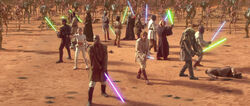
The Clone Wars would bring about a multitude of changes in lightsaber combat, as the more moderate forms the Jedi had specialized in for the last millennia proved lacking on the battlefield, calling for specialist combat styles. Notably, all the Niman practitioners involved in the Battle of Geonosis perished in combat.[3] In preparation for the Sith-orchestrated war, Dooku recruited several other duelists into his personal cadre of Dark Acolytes, notables being the fallen Sora Bulq and the Rattataki warlord Asajj Ventress.[7] Ventress' skills with the lightsaber were sufficient to impress Dooku and Sidious, and she was provided with further instruction from the former, notably in Makashi lightsaber combat.[28] Dooku also trained the Kaleesh cyborg Grievous in lightsaber combat, which Grievous was capable of learning because of the enhanced speed and reflexes of his mechanical body. Grievous would become one of the most prolific Jedi hunters of the era, collecting their lightsabers as grisly trophies, and defeating such notables as, Shaak Ti, and Eeth Koth, as well as dueling Mace Windu to a stalemate.[29][30][31] Other great duelists who became casualties of the war included Sora Bulq and Depa Billaba, leaving Mace Windu as the last master of Vaapad.[32]
By the end of the war, Dooku and Grievous were slain by Skywalker and Kenobi, respectively. Their vastly increased skill marked them as two of the finest duelists in the Jedi Order, with Dooku crediting Skywalker as the finest Djem So stylist that he had ever seen, and Mace Windu recognizing Kenobi as "the Master of Soresu". Windu's Vaapad style also faced its own ultimate test during his confrontation with Darth Sidious, revealed to be the Republic Supreme Chancellor Palpatine. Palpatine's advanced combat skills and Dark side powers allowed him to strike down Agen Kolar and Saesee Tiin instantly. Kit Fisto and Windu were left alone to battle the vicious Sith Lord. Fisto's swordsmanship barely enabled him to hold Sidious off before he, too, fell. Three of the best swordsmen on the Jedi Council were now dead, forcing Windu to fully channel his Vaapad. The feedback loop of power formed by Windu's Vaapad left both combatants in a contest of indefinite length, until Windu managed to seize the tactical advantage, disarming Palpatine and seemingly defeating the Dark Lord of the Sith. However, Windu's apparent victory wouldn't last long, as Anakin Skywalker intervened, defecting to the Sith and cutting off Windu's sword hand, leaving him vulnerable to Palpatine's Sith powers. Mace Windu, one of the greatest duelists in the Jedi Order, considered second only to Yoda, was dead.[32]
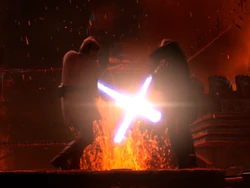
Skywalker, now Darth Vader, would spearhead the sack of the Jedi Temple, personally felling many of the Jedi within, including the children. Even the Jedi swordmaster and Council member Cin Drallig was unable to hold out long against Vader's brutal intensity. Vader would only find his match in his former master; Kenobi's mastery of defensive Soresu proved to be the perfect foil to Vader's all out offense. In one of the greatest lightsaber duels of all time, Kenobi would give ground before Darth Vader's relentless attack, guiding the battle to a location of his choice and seizing the tactical advantage. Overestimating his abilities, Vader attempted to vault over Kenobi but was dismembered by his former master and left to die on the shore of a Mustafar lava river. He only survived when Palpatine, fresh from his own contest with Yoda, rescued him. Realizing that the new Sith Order could not be brought down through martial might, Kenobi and Yoda went into hiding traveling to Tatooine and Dagobah respectively.[32][33]
Developments during the Great Jedi Purge

With the Jedi Order essentially destroyed, lightsaber combat development slowed to a crawl, and most efforts were spearheaded by the Sith. However, the combat forms themselves would still be preserved in surviving records and holocrons, as well as among the Sith.[7] Nonetheless, this time period saw the rise of Darth Vader. Now encumbered by his heavy life-support armor, Vader was forced to customize and adjust his lightsaber technique to compensate. His resulting combat form included elements from numerous techniques of combat, relying on brute force and precision to counter the more acrobatic fighting forms the Jedi survivors favored. With this unique, though somewhat archaic fighting method, Vader became the most prolific Jedi hunter ever.[34] Vader's skills as a duelist would also carry over to several of his apprentices, such as Starkiller and Kharys. Starkiller practiced Juyo and Soresu, while favoring a Shien-style reversed-grip, and bested skilled duelists as Kazdan Paratus, Rahm Kota, and even Darth Vader when he reached his prime as a lightsaber duelist. He was able to compete with Shaak Ti not far off from his prime, but had to use the Force to best her. Kharys created the Trispzest fighting style, a combination of traditional S'kytri aerial dueling and Form VII lightsaber combat.[8] Starkiller ultimately rebelled against his master, and eventually managed to defeat Vader before perishing in a confrontation with Palpatine. This era also saw the emergence of the Emperor's Shadow Guard and the Imperial Saber Guard. The Shadow Guardsman favored Lightsaber pikes, and typically operated as Palpatine's enforcers, while the Saber Guardsman were provided with standard lightsabers and were provided with the prerequisite tutoring, and strongly favored Shien-style reversed grips. Both groups were highly effective on the battle field, though considerably less so against trained Jedi duelists, such as Starkiller or his clone.[9][35]
Arguably the greatest lightsaber duelist of his age, Luke Skywalker was an absolute natural with the weapon. After only a single training session with Obi-Wan Kenobi, Skywalker was already highly competent at blast-deflection, and he improved his technique over the next three years through pure improvisation.[3] Within months, he was skilled enough to overcome Vader's former student Kharys, a practitioner of Form VII lightsaber combat and creator of the Trispzest style.[36][37] His capabilities were further developed during his training under Yoda, and Skywalker's resulting combat style was an instinctual mimicry of Vader's personalized variation on Form V,[3] with elements of Ataru and Soresu included.[38][39] By 3 ABY, he was capable enough to hold his own against Darth Vader, outperforming many of the fully trained Jedi knights the Dark Lord had engaged in the past. Merely a year after this encounter, Skywalker bested Vader with a furious demonstration of his own technique.[3]
Redevelopment
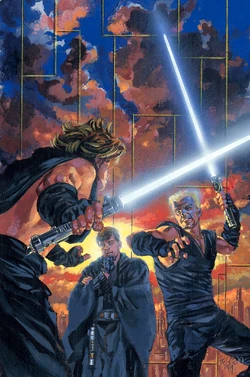
Such training would lay the foundation for any lightsaber training we do later.Kam Solusar
Skywalker would eventually meet his match in Lumiya, a Vader-trained Dark Jedi turned Sith Acolyte.[7] Lumiya wielded a unique lightwhip against Luke, with lashes of both energy and metals. As Lumiya noted, Luke's Jedi training only prepared him for a weapon that was either energy or solid, not one that was both. Luke would quickly adapt, constructing a shoto lightsaber and wielding it as a secondary weapon, allowing him to engage the whip's energy tendrils with one blade while shredding the solid ones with the other.[41] Skywalker would eventually develop to the point where he could compete with the resurrected Palpatine himself in duels, slicing off the Sith Lord's hand.[42] When Luke set about reestablishing the Jedi Order, he was aided in combat techniques by Kam Solusar, who was trained in lightsaber combat by Palpatine's Dark Side Elite, and Corran Horn, a former member of Corellian Security Force who had training in various unarmed combat techniques. It should be noted that many of Skywalker's students were capable of standing toe-to-toe with him, no doubt due to their familiarity with his fighting methods.[40]
While Luke had been provided with formal training in Ataru by Master Yoda, passing this on to his own students,[43] the loss of so much knowledge from the old Jedi Order, including many lightsaber combat techniques, forced Luke's new order to essentially start from scratch. Kam Solusar trained the students in the three rings of defense, while Corran Horn trained them in many of CorSec's combat techniques.[40] The three forms of the Jedi Order were eventually created, each specializing in a different aspect of combat. The Strong style focused on brute strength and offense, often at the expense of defense. The Fast style focused on speed and precision, and was especially good for blast-deflection. The Medium style balanced out between the previous two, and oftentimes acted as a tutorial form, much like Shii-Cho for the old Jedi Order.[44][45] One of the finest students of the academy, Kyle Katarn, practiced all three and eventually attained the rank of Jedi Battlemaster. When the seven forms of the original order were rediscovered, Katarn went on to master Djem So as well.[46]
Over the next century and a half, the various lightsaber fighting forms would experience few major changes, though many masterful duelists would rise to prominence over the years. The Imperial Knight would develop combat styles unique to their organization, the aggressive Praetoria Vonil and defensive Praetoria Ishu. However, these two forms were practiced in addition to classical lightsaber forms, and were designed to encourage and focus on teamwork rather than individual prowess.[47]
Basic Moves and Maneuvers
Every feint, every dodge, every block is a trap to the unwary.Lightsaber combat tenet
Body _target Zones
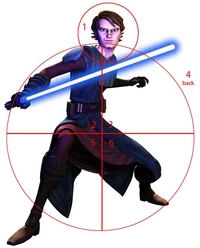
Many of the basics of lightsaber combat were established by the Shii-Cho lightsaber form, as it was the first form developed, and was specialized towards training individuals in the use of lightsabers.[3] Attacks and parries in lightsaber combat are described by the body zones they _target. In idealized sparring drills, most attacks are executed with horizontal swipes, while parries are carried out with vertical blocks meant to push the point of the enemy's blade away, with the exception of the "Attack 1" and "Parry 1", which are reversed.[39]
Zone 1:
- The Head. A zone 1 attack consists of a vertical chop at the head, with the goal of vertically bisecting the opponent, and the corresponding parry is a horizontal block.[49] A classic zone 1 attack was typically preceded by a high guard position, though the zone 4 parry position was also used for this purpose.[39][33] The zone 1 parry position was a horizontal guard, with the blade held at head-height and angled across the body.[49] It was not unheard of for a zone 1 attack to be deflected aside by having a zone 1 parry transition into a zone 2/3 drop parry position.[33]
Zone 2:
- The Right Arm and Side. Zone 2 attacks were horizontal sideswipes, with the corresponding counter being a vertical parry position. Shii-Cho sparring drills had the handle held at waist height with the blade extended upwards, though other combat forms employed drop parries with the handle held high.[49] Assuming a humanoid duelist's right arm was his dominant, any strikes against his weapon arm would correspond with Zone 2 attacks.
Zone 3:
- The Left Arm and Side. Zone 3 attacks are much the same as zone 2, albeit the directions are reversed.[49] Assuming a humanoid duelist's left arm was his dominant, any strikes against his weapon arm would correspond with Zone 3 attacks.
Zone 4:
- Back. Zone 4 encompasses the entire midsection and torso, but refers specifically to the back. A successful Zone 4 attack is almost always fatal.[50] As the classic Parry 4 position is a drop parry position with the blade angled downwards behind the duelist's back, the classic Attack 4 is likely a variation on Zone 2 and 3 attacks.[49] An alternate, albeit more awkward, Parry 4 position has the hilt held behind the back at waist height, with the blade extended upwards.[51]
Zone 5 / 6:
- Zones 5 and 6 referred to the right and left leg, respectively. Zone 5 and 6 attacks were low sideswipes or slashes, while the corresponding defensive positions were drop parries with the hilt held at the waist.[49]
The Three Rings of Defense
- Outer Ring
The Outer ring of defense relied on grand sweeping blows to attack at range. The wide attacks took longer to deliver, but were very powerful. The Outer ring consisted of four guard positions, all with the blade held diagonally: the upper right, upper left, lower right and lower left.[40]
- Middle Ring
The Middle ring of defense was designed to pick up quicker blows and block them, though it was also effective for blast-deflection. The guard positions all featured the blade being held at right angles, with the upper and lower guards being horizontal, while the left and right positions being vertical.[40]
- Inner Ring
The Inner ring was the last line of defense, dangerous to be attacking or defending from. It was proof against lunging attacks, and relied on parries instead of blocks. It had only a single guard position, with the hilt covering the navel. Attacks would be deflected by angling the blades tip and shunting them aside with the lower third of the blade, facilitating a swift counter towards the opponents chest or abdomen.[40]
Marks of Contact
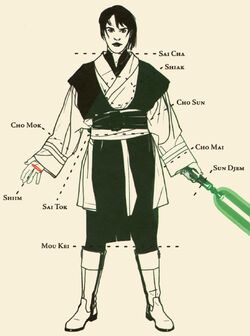
All Jedi forms involve the same marks of contact, describing the objectives, maneuvers to use, and the various outcomes that could arise out of a fight involving lightsabers as weapons. They helped focus a Jedi's attacks and defenses on a few clearer categories, rather than diffusing awareness across an infinite number of possibilities in a duel.[3]
- Sun djem
The sun djem was the act of disarming the opponent, the objective usually being not to physically harm them.[3] The classic Shii-Cho move, the Disarming Slash, was specialized towards executing the sun djem.[38]
- Shiim
The shiim was a more minute wound to an opponent by the edge of a lightsaber's blade.[3] The shiim could be applied anywhere on the body, and was not specific to any zone.
- Cho mai
The cho mai was the amputation an opponent's weapon-hand.[3]
- Cho sun
The cho sun was the amputation an opponent's weapon-arm.[3]
- Cho mok
The cho mok was the amputation an opponent's limb, such as a humanoid's arm or leg.[3]
- Shiak
The shiak was the act of stabbing an opponent.[3]
- Sai cha
The sai cha was the decapitation of the opponent.[3] Being a sideswipe at an opponents side and neck, the sai cha corresponded with Zone 2 and 3 attacks.[49]
- Sai tok
The sai tok was the act of cutting an opponent in half, usually separating his or her legs from the torso at the waist, but vertical bisections corresponding with Zone 1 attacks were not unheard of.[3][52][27]
- Mou kei
The mou kei was an attack that dismembered an opponent through a circular motion of the lightsaber, aimed at the major limbs.[53] The mou kei, being aimed at all major limbs, lashed out at multiple body zones. Darth Vader's dismemberment on Mustafar could be considered a triple cho mok, as it amputated both of his legs (zone 5/ 6) and his left arm (zone 3).[33]
Ready Stances
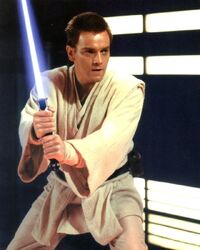
While all the lightsaber forms had their own unique opening and ready stances, a number of positions were standard to lightsaber combat in general.
Having much in common with the Ataru guard, the Jedi ready was the most common stance among Jedi. The dominant foot was held back, with the blade in a vertical parry position on the dominant side.[49]
- Defensive Neutral
The differences between the Defensive Neutral and the Jedi Ready were negligible. The blade was still held in a parry position on the dominant side, though the feet were evenly spaced rather than one held back. This position was intended to provide the maximum amount of blade surface area for blast-deflection, and also to maximize its visual impact as a warning.[49]
- Offensive Neutral
The feet were evenly spaced, with the blade pointed towards the enemy. The stance was intended to provide the minimum visual blade area for _target and tracking.[49]
The Center of Being was a stance used in lightsaber combat. It could also be used for meditation. The stance was used by members of the old Jedi Order. Users of this stance would hold the lightsaber horizontally, with the lightsaber hilt just below the chin.
Moves and Maneuvers
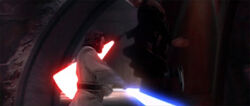
- Jung
The Jung was a 180 degree turn.[49]
- Jung ma
The Jung ma was a 360 degree spin, used to build momentum for an attack.[49]
- Shun
The Shun was a 360 degree spin, during which the lightsaber was held one-handed.[49]
- Sai
The Sai was the act of overleaping an attack at the legs.[49]
- Flowing water
The Flowing Water cut was a technique based on the principle of using the space created when the opponent withdrew their lightsaber offensively to one's own advantage. As the opponent pulled their lightsaber back from a bind, the user would follow it with their blade, in effect causing the opponent to pull the user's blade into themselves.[54]
The Falling Leaf cut was an ancient move that involved the user spinning and making a fast slash at an opponent standing behind them and then return to face the way they were before the maneuver. It was described as spinning one's feet to "slash from the sky".[54]
- Dulon
The Dulon was a lightsaber move where the hilt's pommel would be held at one's midsection with the blade thirty degrees up, and would be slashed at high velocity. The name dulon also referred to a solo lightsaber training.
- Kai-kan
The Kai-kan was not a maneuver per se, but rather a reenactment of a prior lightsaber duel.[49]
Form-specific Maneuvers
As each of the lightsaber combat forms were self-contained martial arts styles, they each possessed moves and maneuvers unique to them.

- Disarming Slash: A strike directed at the opponent's weapon in an attempt to rip it out of their grasp or destroy it.[38]
- Sarlacc Sweep: A wide sweeping attack in which the duelist struck against multiple enemies.[38]
- Contentious Opportunity: A tactic based upon recognizing and exploiting an opening in the opponent's defense before swiftly moving to strike the exposed enemy.[38]
- Makashi Riposte: A defensive technique where the duelist slightly alters the angle of an opponent's attack before quickly retaliating with a counter strike.[38]
- Circle of Shelter: A technique where the duelist creates a protected area around themselves and their allies, making it difficult for enemies to penetrate.[38]
- Deflecting Slash: A technique where the duelist redirects the momentum generated by deflecting an enemy projectile into a slashing attack at an adjacent _target.[38]
- Hawk-Bat Swoop: Was intended to allow a combatant to quickly strike their opponent without giving them a chance to react.[38]
- Saber Swarm: Numerous short strikes were aimed at the adversary.[38]
- Barrier of Blades: Defended the user from blasterfire and redirected some of the incoming blasts.[38]
- Falling Avalanche: An overhand power blow that crashed down upon an opponent with incredible force.[38]
- Fluid Riposte: A smooth transition from parrying an attack to a counterstrike.[38]
- Shien Deflection: Simultaneously deflect weapons fire and leap towards an opponent.[38]
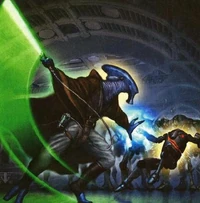
- Draw Closer: It consisted of the duelist telekinetically seizing an opponent and pulling the enemy into the path of their blade.[38]
- Pushing Slash: The duelist would slash an opponent before blasting him aside with a Force push.[38]
- Assured Strike: Trading sheer power for a near-certainty of landing a hit.[38]
- Vornskr's Ferocity: Involved "ferocious" attacking of an opponent.[38]
- Swift Flank: The user leaped or dashed around an opponent to make a quick strike. The speed of the maneuver was intended to catch opponents off guard.[38]
- Tempered Aggression: Used to describe the ferocity of the Vaapad form, but with more control against succumbing to the dark side even in the heat of battle.[38]
- High Ground Defense: Usually involves environment, combatants made use of large amounts of terrain, trying to maneuver their opponents into vulnerable areas during the course of battles that involved Sokan techniques.[38]
- Unhindered Charge: Rapid movement towards the opponent, ignoring difficult terrain and obstacles.[38]
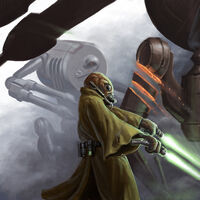
- Twin Strike: A dual-wielding strike that the character simultaneously swings both lightsabers to act as a strong-attack. Both lightsabers meet the _target or object.[38]
- Rising Whirlwind: A duelist swings his lightsabers about his body, creating a brilliant whirlwind.[38]
- Pass The Blade: The duelist deactivates his blade as he attacks, bypassing the opponent's block before igniting it into the hapless foe.[38]
- Unbalancing Block: The duelist catches the opponent's blade with his own before momentarily deactivating it, causing the opponent to stumble and leave himself open.[38]
- Flash Slash: Activation of the Duelist's blade for only a moment, allowing just enough time for the blade to reach full length while being swung, and then deactivated again.
- Spinning attack: The flying duelist would hover in one spot and spin wildly, lashing out at multiple opponents.
Training Methods
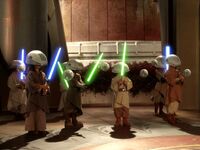
The various lightsaber training methods were largely devised by the Jedi Order, with other organizations borrowing elements for their own use.[19] Most of the Jedi training elements were established by the Shii-Cho, which would continue to find a niche as a tutorial form.[3]
In order to teach students to draw upon the Force rather than rely on their senses, early level Shii-Cho blast-deflect training was conducted with a blindfold, forcing the initiate to rely upon his instincts.[55] Later training was conducted through the use of sequences and velocities, the continuous repetition, making the moves instinctive reflexes. These training regimens were carried over to all following lightsaber combat forms, which used similar methods.[3][19]
Sequences
Sequences were precisely choreographed series of attacks and parries that flowed together smoothly and were used during combat. Each form of lightsaber combat had its own sequences, and there were hundreds of different sequences which could be applied to various combat situations.[19]
Some believed that using sequences in combat was superior to using individual moves, because taking time to consider and use moves individually in combat was slow and inefficient, and using sequences instead of individualized moves was faster and more fluid, providing significant advantages.[19]
Sparring

Sparring was mock combat between two duelists. Sparring sessions provided novices with the opportunity to test their skills against an equal or greater opponent, and learn from their mistakes. Many fully trained duelists would take to frequent sparring sessions with contemporaries to ensure that their skills didn't atrophy, sometimes opting for training droids in the absence of live sparring partners.[56][19]
While most sparring matches were relatively free-form, there were certain styles of matches governed by a strict set of rules. These more specialized matches were intended to develop skills in specific ways, such as developing timing or consistency.[38]
Dulon
The term "dulon" typically referred to a lightsaber move where the duelist would hold his hilt's pommel at one's midsection with the blade thirty degrees up, and would be slashed at high velocity. However, the term also referred to a solo lightsaber training exercise in which a Padawan practiced sequences of moves against imaginary opponents.
Velocities

Velocities involved two students practicing sequences of attacks and parries against each other, repeating the same patterns over and over, while constantly increasing the speed of the movements until one opponent got hit, or decided to yield by saying "Solah."[49]
Twin Suns
In this form of practice, two Jedi would use the Force to rise and land like two suns crossing the sky. It required a great mastery in lightsaber combat, high attunement with the Force and precise timing. This technique required two Jedi to stand at the opposite ends of an open area. Then the combatants would start running at each other and make a Force Jump toward the opponent. While in the air the Jedi would activate their lightsabers and when crossed beside in mid-air, they would strike at one another, trying to harmlessly cut a piece of opponent's clothing and then deactivate the lightsaber before landing on the ground.[38]
Faalo's cadences
Faalo's cadences were a series of lightsaber training techniques developed by the famed Jedi Master, Vo'ren Faalo. In each of Vo'ren Faalo's cadences, the primary practice is to stand in a circle of candles with ball bearings atop them, and attempt to strike the ball bearings without hitting the candles. As the duelist proceeds through each of the cadences, the number of candles would be incrementally increased until the fifth, where the duelist will have achieved such a state of mastery that the candles are unnecessary, as the duelist will simply know when he has performed the sequence correctly.[38]
Trial of Skill
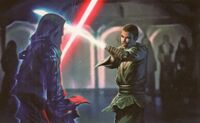
You will need all of your skill to survive.Spirit of Kento Marek, to his son
The Trial of Skill was one of the oldest trials in the battery of tests preferred by the Order. While the test did consist of numerous displays of lightsaber technique, the main thing that the battlemaster looked for when judging a potential Knight was their ability to avoid distraction through self-discipline. Before its formalization, the trial was made up of acrobatic feats, while using the Force to levitate objects in the midst of storms. As the test was incorporated into the more standard academy testing, the High Council required that each participant face off against some form of adversary, though the individual or individuals they faced varied in species or allegiance, and could be made of flesh and blood or a clever simulacrum created from archived data. In some cases, Padawans were forced to compete with the battlemaster in a duel, or even the Grand Master, and outlast their attacks. Other students might face many opponents, some of them attacking with a lightsaber, others manipulating perception or altering the environment in the chamber. Additionally, the Council could opt to use the simulacrum program and send any number of Sith Lords to test the stamina of a young Padawan.[10]
Individual Fighting Forms
According to the Archives, there are several styles of lightsaber combat, known as forms. Each developed to overcome the prevalent threats of their age.C-3PO
Seven Forms of the Jedi Order
Form I: Shii-Cho
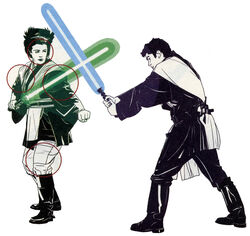
Form I, also called Shii-Cho, requires little explanation, as every Jedi youngling learns the basics of attack, parry, body _target zones, and practice drills called velocities.Cin Drallig
As the most ancient style of lightsaber combat, Shii-Cho was developed during the transition period from swords to lightsabers. Lightsabers were wielded in a manner similar to swords, so many of the maneuvers, such as attacks or parries, remained unchanged, as the key principles of the old sword-fighting methods continued to be incorporated. The simplicity and persistent methods of the form led it to being dubbed the "Way of the Sarlacc" and the "Determination Form".[7] Shii-Cho swordplay was simplistic and raw, although masters of Shii-Cho such as Kit Fisto proved it to be deadly, too. In the hands of a master, the bladework was described as "like watching water flow over the falls."[59] However, less adept practitioners displayed much more basic and somewhat clumsy performance. In combat, Form I encouraged deliberate tactics, calling for continuous, step-by-step advancement while cutting off the opponent's angles.[32] Shii-Cho was specialized towards engaging multiple opponents, the wide, sweeping motions being ideally suited towards attacking numerous adversaries. However, Form I was not as useful against single opponents, as such enemies had complete mobility and could find a weakness in Shii-Cho's comparatively clumsy bladework.[1] Shii-Cho fostered an emotionally-heated mindset, which resulted in the considerable temptation to execute combat with lethal intent, requiring great restraint to exercise the form without going too far. Despite the pull to kill, the style was designed for the purpose of disarming without seriously injuring.[60][3]
As the most simplistic form, Shii-Cho was the first form taught to initiates within the Jedi Order. Form I training provided the basic knowledge of the sword-fighting principles and blast-deflection skill that was required for practice of all the other forms.[3] In order to teach students to draw upon the Force rather than rely on their senses, early level Shii-Cho blast-deflect training was conducted with a blindfold, forcing the initiate to rely upon his or her instincts.[55] Later training was conducted through the use of sequences and velocities, the continuous repetition making the moves instinctive reflexes. These training regimens were carried over to all following lightsaber combat forms, which used similar methods.[3][19] Shii-Cho philosophy emphasized victory without injury, and as such, the sun djem mark of contact was traditionally employed by Form I practitioners. Keeping with the use of sun djem, one of the attacks utilized by Form I practitioners was referred to as the "Disarming Slash", consisting of a strike directed at the opponent's weapon in an attempt to rip it out of their grasp.[38]
Form II: Makashi
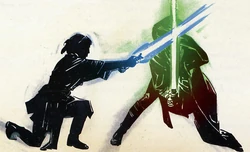
Form II, also called Makashi, represents the ultimate refinement of lightsaber-to-lightsaber combat.Cin Drallig on Form II
Makashi was the most dueling-centric of the seven forms, developed during an era where engagements with Darksiders and rogue Jedi became an almost routine activity. Form II's primary purpose was to serve as a counter to the first form; Shii-Cho. Makashi relied on precision swordplay to counter the sweeping movements demonstrated by Shii-Cho, and a heavy focus on protecting one's weapon to avoid being disarmed, the primary goal of Form I.[3] Form II emphasized fluid motion and anticipation of a weapon being swung at its _target, and so required very fluid movements of both the blade and the body. Timing, accuracy, and skill, rather than strength, were relied-upon to defeat one's opponent. With a skilled practitioner, the results were deadly. Makashi users were often elegant, precise, calm, confident to the point of arrogance (as befit Dooku's personality, a notable master of Makashi). Form II users were supremely confident in their chances for victory, and often looked so relaxed when they were fighting they even appeared to be dancing.[23] Makashi duelists also trained themselves to avoid enslavement to form, as such enslavement opened the practitioner to be defeated by predictability and the unforeseen.[29]
Due to Form II's emphasis on blade manipulation, and its many fluid one-handed moves, Makashi practitioners often wielded lightsabers that were specialized for such use. The most prominent weapon for this purpose was the curved-hilted lightsaber. These weapons were used because the curved hilt fit better into the palm, granting better blade control and allowing for greater precision and strength. In addition to this, wielders often created highly decorated weapons, and occasionally included blade-guards, as shown with Dooku's lightsaber. The other, considerably rarer, weapon type was the Lightfoil, a specialized type of lightsaber used by the Mecrosa Order. Original lightfoils were built with small handles for exclusively one-handed usage, and were much better balanced than typical lightsabers, allowing for greater precision.[38]
Form III: Soresu
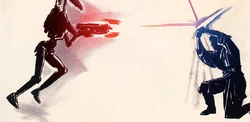
A… defensive technique. But effective. Use it if you do not wish to be hit, or if you are facing many opponents with blasters. With a lightsaber blade and enough skill in deflection, it is an excellent offense against blasters, but in other situations, it merely delays the inevitable.Kreia
The original purpose of the Soresu form was to counter blaster-wielding opponents, as the previous combat styles focused on lightsaber dueling. Becoming the most defensive of the seven forms, Soresu utilized tight moves, subtle dodges and short sweeps designed to provide maximum defensive coverage, leaving the duelist less exposed to ranged fire. Over time, Form III came to transcend this basic origin and become an expression of non-aggressive Jedi philosophy.[3][32] Soresu utilized motions that occurred very close to the body, in an attempt to achieve near-total protection and expend as little energy as possible while executing moves. Form III stressed quick reflexes and fast positional transition, in order to overcome the rapidity with which a blaster could be fired. This technique minimized the body's exposure, making a well-trained practitioner nearly invincible. Form III involved preparation for prolonged battles where the user observed and learned as much as possible about their opponent's or opponents' technique while engaged in combat. Also, by being more capable in lengthy battles, a Soresu user had the ability to gain control of a combat situation, creating multiple options for the Jedi employing the form. A Form III user could choose to kill, disarm, or even reason with their opponent.[20]
Truly focused masters of Soresu were very formidable due to their strong defense technique. However, Form III merely facilitated survival rather than victory. Form III initiates were more than capable of defending themselves from attack, but they needed a large amount of experience to learn how to effectively counter-attack and entrap opponents. Masters had to maintain an incredibly strong focus on the center of the combat circle, since the defensive tactics of the form included guards and parries engaged very close to the body. Notable Masters such as Obi-Wan Kenobi could defend until their opponent made a fault, and using it to their advantage. Jedi who left small lapses in their otherwise strong defense left little room to avoid injury.[39]
Form IV: Ataru
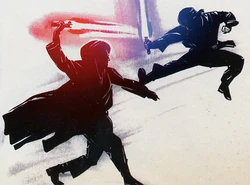
Ataru is the name given to the movements of this form - though it is aggressive, it is focused, and its best use is in combat against a single opponent.Zez-Kai Ell
Ataru was an aggressive combat form relying on a combination of strength, speed and agility. Practitioners of Ataru were always on the offensive, attacking with wide, fast, and powerful swings, constantly calling upon the Force to aid in their movements and attacks. By allowing the Force to flow throughout their body, they could overcome their physical limitations (including old age, as was the case with Master Yoda, a notable master of Ataru) and perform amazing feats of acrobatics, such as somersaults and backflips, not only for attack, but also to evade the attacks and strikes of their opponents.[3]
The standard components of Form IV focused on application of and smooth transition between the three axes of rotation in a three-dimensional space; the su ma. Specifically, the jung su ma (spinning), ton su ma (somersaults), and en su ma (cartwheels). Those who used Form IV could move at high speeds and could rain strong blows, jumping and attacking through the air. Powerful and quick spinning attacks could be utilized from all angles, either from ground or air. A master in Ataru combat could appear like a blur to their opponents, attacking from all directions—from the front, the sides, overhead, or behind. The Force not only allowed them to perform athletic feats not possible otherwise, but it also helped guide their actions and movements in combat. Obi-Wan Kenobi's backflip upon being kicked in the head is a perfect example of a Form IV recovery, redirecting the kinetic energy.[3][39]
Form V: Shien/Djem So
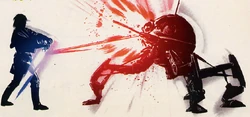
Peace through superior firepowerJedi maxim on Form V
Form V was created by Form III masters who desired a more offensive style, since the defensive nature of Form III could lead to prolonged combat, sometimes dangerously so. It evolved into an accepted style by combining the defensive maneuvers of Form III with the more aggressive philosophy and tactics of Form II. Form V also required a higher level of physical strength than the other lightsaber forms, due to its focus on complete domination of opponents.[3] The form was developed alongside Form IV at a time when the Jedi were increasingly called upon to actively keep the peace.[7] Form V had two distinct variations: Shien and Djem So.[7]
Classic Form V, Shien was developed first. Known as the "Perseverance Form", Shien was designed to protect against enemy blaster fire and strikes without compromising one's ability to launch powerful counterattacks. With its focus against blaster fire, Shien kept in mind that Jedi were often outnumbered by their opponents and needed to defend themselves while retaining offensive capability. However, it lacked effectiveness against single opponents.[1] Shien practitioners were known to favor, or at least regularly utilize, reversed grips.[39]
Whereas Shien specialized in blast-deflection, the more advanced Djem So focused on lightsaber dueling.[9] Utilizing a combination of blocks and parries, a Djem So user maintained a proper foundation in terms of defense against both ranged and melee attacks, but rather than counter only when necessary as per Soresu training regimens, Djem So actively pressed the offense.[3] Djem So placed a heavy focus on brute strength, utilizing wide, powerful strikes and parries. Power attacks from a Djem So user could even knock an opponent back just through sheer kinetic force, throwing them off balance and leaving them vulnerable to further brute force strikes and power blows that sought not just to penetrate an opponent's defense, but drive them back and leave them unable to counter.[19]
Notable masters of Form V include Anakin Skywalker, a master of Djem So, and Ahsoka Tano, a practitioner of Shien.
Form VI: Niman
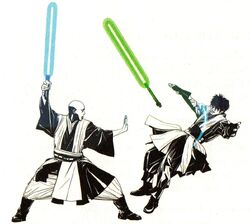
Is Form VI the most worthy of study? No, but in general it is the most practical.Cin Drallig
Niman, the dual-blade style developed by the Royale Macheteros of the Kashi Mer, was named for the dual triumvirate of the Kashi deities. The style was adopted by the Legions of Lettow, a group of Dark Siders responsible for the First Great Schism of the Jedi Order. After the defeat of the Legion at the hands of the Jedi, Niman was adopted by the Jedi order, eventually being refined into the sixth form of lightsaber combat, referred to by the same name.[8]
Form VI attempted to balance all elements of lightsaber combat, combining the techniques from Forms that came before into a less intensely demanding combat style. In practice, Form VI was a combination of older forms (Forms I, III, IV, and V), and all of them in moderation. In the blending, much of the individuality was lost, but the strengths were spread evenly, and there was little weakness in it. Due to its "jack-of-all-trades" nature, the success of this form was largely dependent on the practitioner's intuition, improvisation, and creativity in combat rather than the rote responses derived from other forms. Medium style was based off of Niman due to both of them being a combination of different forms. This broad generalization made Form VI well suited for diplomats, as they could spend their time training in the areas of politics and negotiation instead of combat training.[3]
Notable users of Form VI include Darth Maul, who used it in moderation, although mainly using Form VII (Juyo) and Anakin Skywalker who scarcely used it due to him using Form V (Djem So) more often. Both of these practitioners of Form VI happen to use it as an alternative to their aggressive fighting style, which is common for Form VI users. Other users include Starkiller, Revan, and Obi-Wan Kenobi (Kenobi rarely uses Form VI when dueling, but uses it against other opponents such as droids).
Form VII: Juyo/Vaapad
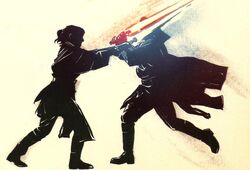
Six there were for generations of Jedi. The seventh, is not well-known. Powerful form it is. Deadliest of all. But dangerous it is, for its master as well as its opponent. Few have studied. One student alone, to mastery has risen.Yoda
Juyo was described as the most vicious form of lightsaber combat, and was said to be filled with both fury and "malignant grace."[9] The form came to be known as the most difficult and demanding in all of saber combat.[7] Skilled combatants with Juyo were said by Jedi Master Vrook Lamar to be able to "eviscerate a lone enemy". According to the Sith Lord Darth Traya, the form was both chaotic and erratic, with a heavy focus on offense.[1]
Jedi Battlemaster Cin Drallig listed bold, direct motions as characteristics of Juyo, qualifying them as more open and kinetic than Form V, but with a less elaborate appearance than Ataru. Drallig contrasted the tactics of Juyo as not nearly as graceful or linked as those of Ataru, instead referring to them as "seemingly unconnected staccato sequences." He also listed one of the strengths of the form as its unpredictability. The form was said to necessitate greater energy than Form V, due to a broader wielding of a user's focus and a deeper emotional link. Despite the challenges inherent in the use of the form, it could serve as a pathway to considerable power.[39]
Vaapad

This is called Vaapad, Kar. How many arms do you see?Mace Windu facing Kar Vastor in unarmed combat
Vaapad was described as more than a fighting style; it was a state of mind that led through the penumbra of the dark side, requiring the user to enjoy the fight, and relish the satisfaction of winning. The practitioner of Vaapad would accept the fury of their opponent, transforming them into one half of a superconducting loop, with the other half being the power of darkness inherent in the opponent.[7] The form was also mentioned with a cautionary warning by the Jedi that use of Vaapad led the user perilously close to the dark side due to its focus on physical combat.[3] Vaapad required a constant and sizable stream of Force use from the user, with a barely contained explosion of Force power essential to all variations of Form VII as another prerequisite for its use. The form's attacks appeared to be unconnected, its motions seemingly unpolished to an untrained observer.[62]
Three Forms of the New Jedi Order
Strong Style
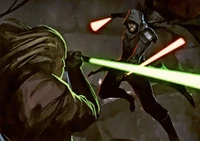
Uses powerful strikes to batter through defenses. This style incorporates great range and power, but often leaves the Jedi open to attackDescription of the strong style
The strong style was based primarily on powerful strikes to batter through an opponent's defense, sacrificing speed for unrivaled power. The strong style covered great distance, and was virtually unstoppable unless the opponent responded in kind. Due to its utilization of strength and power, the strong style would cause more damage than many other forms of lightsaber combat, while its range and power made it especially efficient against single opponents who were armed with melee weapons. In lightsaber duels, the powerful strikes of this style could break through lightsaber blocks with relative ease. On rare occasions when a lightsaber lock occurred, a user could usually win the lock by ripping the opponent's blade away, leaving him defenseless. This style was quite destructive, and if the practitioner were presented with an opening, it would almost always cause a devastating blow.[44][45]
Being based on slow, powerful swinging attacks, users of the strong style would often leave themselves open to counterattacks and open to blaster fire. The style could thus be disadvantageous in one-on-one melee combat in terms of speed comparisons against faster opponents, although its range and penetration power could just as easily negate these disadvantages. It was weak against blaster shots, as the stance required that the user shift the blade quite a bit to cover the body. Thus, it was almost solely utilized in lightsaber combat.[44][45]
Medium Style
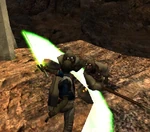
An intermediate style between the fast and the strong styles, the medium style was based on a perfect equilibrium between speed and power. More often than not, the medium style was the first taught to a lightsaber duelist. It was simple in technique, yet more technical and powerful forms could be built from its foundation.[44][45]
This simplicity was both a strength and weakness. It was an excellent style to fall back onto when nothing else worked, and could provide a respectable offense and defense. It could effectively combat blasters and hold less skilled lightsaber duelists at bay. However, more skilled gunslingers (such as Boba Fett) or more talented lightsaber duelists (such as Luke Skywalker) would very rapidly break a medium style defense. The same holds true in offense, as a skilled duelist would rapidly destroy the user's momentum and counterattack.[44][45]
Fast Style
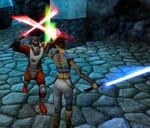
Consisting of short and quick motions with the blade that could be chained and combined almost indefinitely, this style allowed for multiple attacks at an extremely fast pace. Its obvious advantage was that it was efficient in one-on-one combat against slower opponents with lax defenses or many opponents who were not wielding melee weapons, particularly when combined with Force speed. Among all the styles, this style provided the best defense against blaster fire. In lightsaber combat, it was a powerful defensive technique, as the user could create a very strong defense against multiple opponents or a single, stronger opponent.[44][45]
Relying primarily on speed and multiple attacks, the disadvantages of the fast style were equally obvious. Firstly, its use of fast strikes limited the amount of power that was put into a blow, making it easy for a strike to be parried or overpowered. Secondly, its range was considerably short, making it a less effective offense against a wide-spread of multiple opponents. Third, the fast style's defenses could quickly be broken through if an opponent was much more physically powerful than the user. Since the blade was kept so close to the body, a strong, cunning opponent will simply hammer the user's blade in the hopes that the practitioner would tire and leave themselves open.[44][45]
Other Fighting Forms and Styles
The Unorthodox and Hybrid Fighting Methods
Stop using the standard attacks, use the unorthodox!Dooku to Grievous
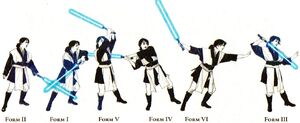
There were many fighting styles that predated or coexisted with the classic Jedi forms that were adopted by individual Jedi duelists. In fact, study into some of these more esoteric fighting forms, such as Sokan or mounted lightsaber combat, were made available within the Temple walls. Also, Jedi were encouraged to develop hybrid fighting forms, or to study alternate fighting styles to back up their primary. Such fighting forms have taken many shapes, from simple personalized variations of other styles, to advanced hybrid fighting forms. For example, Niman practitioners were encouraged to study Soresu, the pure root of Form VI. Obi-Wan Kenobi began studying Soresu to compensate for the defensive weaknesses of Ataru, though he eventually switched entirely to the former.[10][49]
However, other duelists discouraged such hybrid methods, a notable being Dooku. While Dooku advocated the application of unorthodox maneuvers, he focused exclusively on Makashi, and referred to hybrid duelists as mere "dabblers" lacking mastery. He even went so far as to smear Jedi Battlemasters for this, maintaining that their attempts to master multiple combat forms was taking on too much, and they could still be beaten by a specialist in a single form.[10] One of the facts supporting this viewpoint was the death of Battlemaster Cin Drallig at the hands of Darth Vader, a Form V specialist.[32] Vader himself would later become a hybrid duelist some time after being placed in his life supporting armor, integrated techniques from all seven lightsaber styles into his personalized Form V variant, and switching back and forth between styles to suit the situation.
Trispzest
You could be the finest warrior in creation—on the ground—but now you are in my element!Kharys
A combination of elements of Form VII and traditional S'kytri aerial dueling, Trispzest was a type of aerial lightsaber combat originally developed by the airborne Force-sensitive Majestrix of Skye, Kharys. Trispzest, which meant heart palpitation in the S'kytric language, would allow the combatant to utilize the advantages of flying in battle against grounded units—whom the S'kytri would derogatively refer to as "walkers". In Trispzest, emphasis was placed on the use of the sai cha technique to decapitate "walkers".[8] Trispzest had many advantages, but one fatal weakness, as the combatant was open to attacks from directly below him or her by grounded units. Kyle Katarn took advantage of this weakness when, dropping to the ground and lunging his lightsaber upwards as Maw passed over him, he injured Maw during a duel on Ruusan.[64]
Tràkata
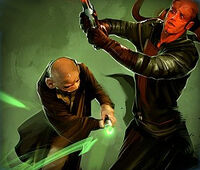
The Tràkata style was based around the unique ability of lightsabers to turn on and off, activating and deactivating the blade in the heat of combat to slip past enemy defenses, or trick them into over-extending themselves. Philosophically, Tràkata involved practical combat and deception, rather than the more traditional single-minded and determined tactics that were the hallmarks of the Jedi and Sith. Sith had difficulty applying this style, as their power came from passion and rage rather than level-headed tactical ingenuity, and the Jedi refrained from this style due to their unwillingness to rely on deception. Also, deactivating one's lightsaber during combat offered greater control over the Force due to the removed distraction.[65]
Sokan
For the most part, Sokan was a principle of lightsaber combat, rather than a true form. Developed by the ancient Jedi Knights during the Great Hyperspace War, Sokan teaching revolved around using the environment itself to gain a tactical advantage in combat. Sokan was based on out-maneuvering opponents, using quick tumbling and jumping movements to close the distance and facilitate swift strokes towards the opponent's vital areas. Terrain was heavily relied on for this purpose, and allowed for great speed and mobility, and also facilitated self-defense. Prior to the Clone Wars, Sokan practitioners integrated highly kinetic elements of Ataru with their ancient Sokan techniques to create a blend of styles that relied upon agility.[8]
Mounted Lightsaber Combat
[66]Obi-Wan Kenobi

In this type of combat, the duelist was limited to fighting one-handed, as the other hand was needed for steering the mount. As the duelist would have a height advantage over the opponent, attacks while mounted typically consisted of low lunges and diagonal slashes and arcs. The prime advantage of this type of fighting is the high vantage-point and the speed offered by the mount, though conversely the duelist had to devote effort towards protecting and controlling the mount.[45][66]
Telekinetic Lightsaber Combat
The power of energy over matter…and mind over both.Luke Skywalker
Telekinetic lightsaber combat was the art and practice of wielding one's lightsaber with Force-based telekinesis. It was extremely difficult, and required great aptitude in such applications of the Force. The primary advantages of such a fighting form were obvious; range ceased to be an issue, and the option of wielding numerous lightsabers simultaneously became viable.[1] The most basic application of telekinesis in lightsaber combat was the saber throw. Using the Force to guide the lightsabers arc through the air, users could throw their lightsabers in a boomerang fashion, cutting apart obstacles and surprising foes.[67] More adept users of such a technique could hurl their lightsabers across great distances, make mid-air course-corrections, or simply allow their lightsaber to hover in place.[34]
Dun Möch
Make him doubt himself, his beliefs, or his intentions. Such things disrupt connections to the Force—and death soon follows.HK-47 to the Jedi Exile, on how to defeat Darth Sion
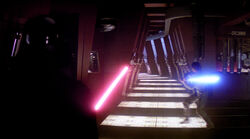
Dun Möch was a traditional Sith tactic based around psychological warfare. Primarily, the practitioner relied on taunts that exposed an opponents inner doubts and weaknesses, disrupting their concentration.[3] Proper execution of Dun Möch called for great patience and control, a rare trait among the Sith, especially those of the earlier eras. One of the finest demonstrations of this technique was in Darth Bane's defeat of Sirak during their time at the Sith academy on Korriban. He demonstrated the need for patience by drawing out the battle to take advantage of Sirak's lack of endurance, and exhibited fine control by withholding from striking an early killing blow as Sirak's form began to slip. Rather than settle for a quick victory, Bane sought to completely destroy Sirak, allowing the tantalizing closeness of victory to fuel his rage, unleashing it in a powerful blow that disarmed Sirak, ending the duel.[19]
"Form Zero"
Remember, your lightsaber is an invaluable tool. Even when inactive, it can defuse a potentially volatile situation. Trust me on that.Kyle Katarn
Form "Zero" was not an actual form of lightsaber combat, but rather an ethical principle. It was an expression of the idea that a Jedi should know when to use their lightsabers, and when to withhold from resorting to force and instead find an alternative means of solving a problem. This idea was defined by Jedi Master Yoda to address the need of the Jedi to restrain themselves when tempted to use "aggressive negotiations," and instead use another well-developed Jedi skill, such as the Jedi mind trick. This was a method used to arrive at a solution without resorting to violence.[8]
Lus-ma
[29]Dooku comments an application of Lus-ma by Grievous and his IG-100 MagnaGuards during a sparring match
An obscure lightsaber technique, Lus-ma was one of the fighting forms that Count Dooku trained Grievous and his IG-100 MagnaGuards in. Beyond the fact that one of these initiates used Lus-ma to counter a Soresu move, next to nothing is known of the style.[29]
Su ma
Su ma was the use of rotation in the Jedi Knight's form of lightsaber combat, it was composed by three forms. One, the ton su ma, was the use of somersaults in combat. Another, the en su ma, was the use of cartwheels in combat.
Weapon-specific Fighting Forms

Due to the incredible variations in lightsaber technology, and the various specialized weapons available, fighting and training methods for the use of these various implements were required. Most weapon variations were fairly minute changes in the size and shape of the lightsaber hilt, with the affects on combat being negligible. Curved-hilt lightsabers and Lightfoils allowed for greater precision and easier one-handed wielding, while Long-handle lightsabers allowed for improved leverage and power. Dual-phase lightsabers allowed for rapid changes in blade-length, and could be used to surprise enemies, but required no dedicated methods of specialized training beyond personal familiarity.[38]
However, other variations on armament, such as double-bladed lightsabers or the wielding of dual-blades, required intense specialized training due to the difficulty in using such weapons.
Jar'Kai (dual-blade) combat
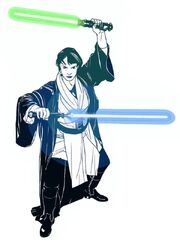
Perhaps you would like to learn something before you die. The use of two blades, one to support the other, can be traced back thousands of years and was common to both of our species. The invention of lightsabers has done nothing to lessen the effectiveness of this strategy—as you are about to learn.Boc Aseca to Kyle Katarn
The Jar'Kai style developed by the Yovshin Swordsmen was named for a city on Atrisia. The city of Jar'Kai was also the site where the original Jar'Kai dueling sabers were crafted. These weapons were utilized by the Yovshin and were designed for the express purpose of being dual-wielded. Niman, the dual-blade style developed by the Royale Macheteros of the Kashi Mer, was named for the dual triumvirate of the Kashi deities. The style was adopted by the Legions of Lettow, a group of Dark Siders responsible for the First Great Schism of the Jedi Order. After the defeat of the Legion at the hands of the Jedi, Niman was adopted by the Jedi order, eventually being refined into the sixth form of lightsaber combat, referred to by the same name. Both styles predated the invention and usage of lightsabers, but being designed to be practiced with swords, they were easily adapted. In addition, the word "Jar'Kai" became a blanket term for dual-blade combat in general, leading to the birth of the term "Jar'Kai tactic", which was to simply employ two blades in combat, regardless of whether one had received training in any dual-blade fighting style.[8]

Dual-blade fighters, whether classical Niman duelists or individuals applying the Jar'Kai tactic, were able to maintain a strong offense, as the speed of attack that two blades allowed would overwhelm most opponents. A typical maneuver was to continually attack with one blade while relying on the other for defensive coverage, ensuring that the duelist could keep up his guard even as he attacked. However, it was common that both blades be used for offensive purposes, keeping up a continuous wave-front assault. Though a complete fighting system in and of itself, Jar'Kai was easily adapted to other styles. After beginning her tutelage under Darth Tyranus, Asajj Ventress quickly applied Makashi techniques to her practice of Jar'Kai. As Makashi was Tyranus's favored form, Jedi Master Luminara Unduli was able to recognize his training techniques in Asajj's fighting abilities, stating as much. Mace Windu also infused Jar'Kai tactics into his own Vaapad style while on a mission on Haruun Kal, his former apprentice; Depa Billaba; doing likewise.[28][61]
Double-bladed lightsaber combat
In combat, your mind tries to keep track of each blade separately, effectively doubling the number of possibilities. But the two blades are connected: by knowing the location of one, you are automatically aware of the location of the other. In actual practice, the double-bladed lightsaber is more limited than the traditional lightsaber. It can do more damage, but it is less precise. It requires longer, sweeping movements that don't transition well into a quick stab or thrust. Because the weapon is difficult to master, however, few among the Jedi-or even the Sith-understand it. They don't know how to attack or defend effectively against it. That gives those of us who use it an advantage over most of our opponents.Blademaster Kas'im
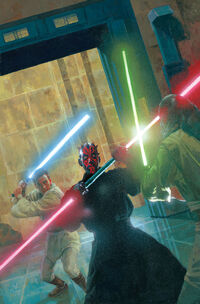
The primary purpose of the double-bladed lightsaber was to allow for a faster rate of attack, unleashing a rapid assault with only a minimum of movement, "more slaughter per swing" as some put it. Saberstaffs were also excellent defensive weapons, as the doubled length of the weapon provided more surface area for deflecting and parrying.[20] In addition to the practical benefits of the weapon, it also possessed a great psychological impact. The dual-blades increased the visual impact of the weapon, and in combat, opponents would intuitively try to track the blades separately rather than as a single weapon, overwhelming them.[19]
However, despite all of the advantages offered by the weapon, its weaknesses were equally obvious. Special training was required to wield the weapon effectively, with those attempting to use it without such discipline likely to bisect or impale themselves.[7] The techniques employable with a double-bladed lightsaber were extremely limited, as the second blade rendered many positions and movements impossible to execute, or required the wielder to twist himself awkwardly around the weapon to do so. Many techniques required the user to perform elaborate flourishes in order to move the staff around their body, leaving them open, and any sort of fighting method that focused on power or penetration was difficult to apply.[19][26] Also, the enlarged hilt common to most double-bladed lightsabers presented a large _target, difficult to defend. Opponents would often attempt to employ the sun djem contact mark, with even experienced saberstaff wielders being vulnerable to this tactic.[26]
Lightsaber pike combat
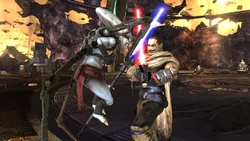
Resembling an ancient pole-arm in many respects, the primary purpose of the lightsaber pike was to allow vastly increased range. The primary feature of the weapon was the long shaft that the lightsaber was mounted on, which was machined from a lightsaber-resistant alloy, such as phrik. The shaft provided several advantages: drastically increased range, use as a close-quarters defensive weapon, with the large surface area of the shaft being used to block enemy strikes, and the improved leverage granted by such a large handle, allowing wielders to dole out devastating power attacks.[38][57]
However, like the double-bladed lightsaber, the weaknesses of such a weapon and the associated combat styles were obvious. The long shaft made many positions and movements awkward, sometimes impossible, to execute, it did not transition well between thrusts and slashes, and required plenty of open space to wield properly.[57]
Lightwhip combat
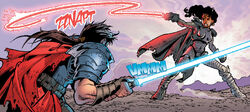
That combination is what defeated him. His Jedi training had prepared him for an energy weapon, or a solid one. Not one that was both at once.Lumiya, explaining the advantages of her whip
Wielded in the same manner as a proper whip, the lightwhip was a rare and exotic weapon, an unfamiliar occurrence among traditional duelists. Due to this, lightwhip wielders enjoyed a considerable amount of leverage over opponents.[19] Along with its rarity, lightwhips also featured copious range, the long, flexible energy strand allowing the wielder to attack from a range of several meters.[41] The weapon was also difficult to defend against, as it could simply flex around an opponent's blade when he attempted to parry.[68] When multiple tassels were included, the whip was able to overwhelm the defenses of enemies by attacking them from all sides.[41]
However, lightwhips featured just as many drawbacks as advantages. The lightwhip blade was difficult to control, able to just as easily maim an untrained wielder as an opponent, and was weaker than the standard lightsaber blade.[38] It needed to be swung wide to gain momentum for attack, and it was difficult to use defensively as flexible tassels are not well suited for parrying, leaving the wielder vulnerable to both great speed and brute force.[69] In fact, lightwhip blades were even known to short out violently when struck with enough force.[41]
Unarmed combat
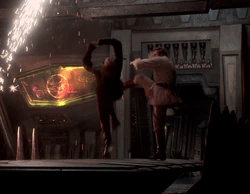
You were at Galidraan…tell me, how did one mere man kill so many of your kind?"
"With his bare hands.Darth Sidious and Darth Tyranus, speaking about Jango Fett
As the various forms of lightsaber combat were all fully developed martial art forms, they were not limited to use with the lightsaber, and unarmed combat training was standard among many Force-based organizations.[71] Most species were known to engage in this kind of combat, and a number of sentient species and cultures also developed it into different martial arts proper; just as the various lightsaber combat forms could be applied unarmed, so too could many of these unarmed combat styles be applied with the lightsaber. Darth Maul and Anoon Bondara were both students of the Teräs Käsi martial art, developed by the Followers of Palawa, who became accomplished lightsaber duelists.[25][72] The Echani martial art was an unarmed combat discipline known to be taught to military special forces throughout the galaxy, and may have been taught to Meetra Surik.[1]
During duels, such physical attacks were applied with astonishing regularity, oftentimes with the goal of disorienting an opponent prior to a finishing attack. As disarming was a common goal in lightsaber duels, it was not unheard of for both opponents to lose their weapons, causing the fight to degenerate into a brawl. In fact, fighters have been known to draw on the Force to augment their speed and strength, allowing them to unleash powerful hits that threw opponents across the room, or literally tear them limb from limb.[4][73]
Behind the scenes
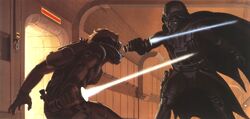
Lightsabers, and by extension lightsaber combat, were inspired by the pirate and romantic films of the 1940s, which heavily featured rapier fencing and the like. In keeping with these romanticized depictions of fighting, the lightsabers were intended to represent the honor and chivalry inherent in the Jedi. Jedi were initially conceived as fighting with swords, but George Lucas wanted to provide them with a technological edge, and created the lightsaber. His rationale was that in an era of energy weapons, lightsabers could be used to deflect the rays, giving birth to the idea of blast-deflection. Lucas wanted the earliest lightsaber duels to feature a very oriental style of fencing, reminiscent of Japanese fighting styles, which involved a great deal of honor and spirituality.[74]
The original lightsaber duel in Star Wars: Episode IV A New Hope was choreographed by Peter Diamond. According to Diamond, George Lucas wanted a broadsword-dueling style of fighting, with a touch of Japanese Kendo included. All of the fighting moves in the duel were two-handed strokes, in keeping with Lucas' initial concept that lightsabers were incredibly heavy and difficult to handle. Also, due to the brittleness of the stunt blades used during this fight, which were little more than wooden dowels, Diamond was forced to instruct Alec Guinness and David Prowse to stop their blades before contact due to their fragility.[75]
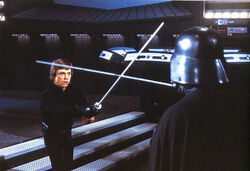
As the Star Wars saga carried on, Lucas rethought the fighting styles. He decided to make them "faster and more intense," symbolizing Luke Skywalker's increasing mastery of the weapon. One-handed fighting methods resembling European rapier fencing came to be included. The choreography of the duels in The Empire Strikes Back and Return of the Jedi was also used to show Luke Skywalker's development as a character. In The Empire Strikes Back, Mark Hamill was choreographed to show Luke Skywalker fighting as hard as he was able against the bitter enemy of Darth Vader, though the duel in Return of the Jedi was more centered on the emotional context of the fight.[74] Also, due to David Prowse's tendency to break the prop lightsaber blades during the filming of A New Hope, all of Darth Vader's fight scenes had Bob Anderson acting as Prowse's fighting double.[76]
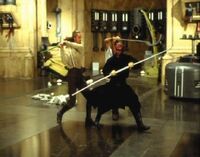
When the prequel trilogy began filming, Peter Diamond was replaced by Nick Gillard, who completely rethought the Jedi fighting styles. George Lucas envisioned that during this time period, the Jedi had reached their peak in terms of martial arts development, so the choreography had to be a great deal faster and more sophisticated.[74] Gillard wanted to convey the sense that the Jedi had studied every single style of swordplay available, his idea being that since they had chosen such a short-range weapon, they would have to be so good if they're up against ray guns and lasers. Gillard choreographed the duels as what he described as "a chessgame played at a thousand miles an hour," with every move being analogous to a check. Aiding Gillard was the martial artist Ray Park, who portrayed Darth Maul, and helped train Liam Neeson and Ewan McGregor.[77][78]
Due to his age and consequent lack of mobility, Christopher Lee was replaced by stunt double Kyle Rowling for Count Dooku's more complex dueling shots. However, Lee was able to perform some of the moves, particularly during the close-up shots. Attack of the Clones was also the first Star Wars film to feature a large number of Jedi in a battlefield situation. To create this, numerous martial artists were hired and filmed either individually or in small groups in front of a blue screen. All the footage was then compiled and edited into vignettes that were composited into either footage of the Arena model, or a computer-generated background.[79][80] Similarly to Christopher Lee, Ian McDiarmid was also replaced by his stunt double due to his age, though he also performed certain moves on the close-up shots.[81]
The seven forms of lightsaber combat received their first description and elaboration in the Fightsaber: Jedi Lightsaber Combat article released in Star Wars Insider 62. While these fighting styles would be mentioned and used in Star Wars: Knights of the Old Republic II: The Sith Lords, Star Wars: Jedi Knight II: Jedi Outcast and its sequel, Jedi Academy would instead use the three styles; Fast, Medium, and Strong. While each of these forms had strong parallels to the Three Rings of Defense described in the 1998 Expanded Universe novel I, Jedi, they may be little more than game mechanics.
In the second draft of what would become Star Wars: Episode IV A New Hope Leia Lars mentions "the seven moves."[82]
Appearances

- ° Star Wars: Tales of the Jedi – The Fall of the Sith Empire
- ° Star Wars: Tales of the Jedi – Ulic Qel-Droma and the Beast Wars of Onderon
- ° Star Wars: Tales of the Jedi – The Saga of Nomi Sunrider
- ° Star Wars: Tales of the Jedi – The Freedon Nadd Uprising
- Tales of the Jedi – Dark Lords of the Sith 1
- Tales of the Jedi – Dark Lords of the Sith 2
- Tales of the Jedi – Dark Lords of the Sith 3
- Tales of the Jedi – Dark Lords of the Sith 4
- Tales of the Jedi – Dark Lords of the Sith 5
- Tales of the Jedi – Dark Lords of the Sith 6
- Tales of the Jedi – The Sith War 1
- Tales of the Jedi – The Sith War 2
- Tales of the Jedi – The Sith War 3
- Tales of the Jedi – The Sith War 4
- Tales of the Jedi – The Sith War 5
- ° Star Wars: Tales of the Jedi – Redemption
- Star Wars: Knights of the Old Republic
- The Old Republic: Revan (and audiobook)
- Star Wars: Knights of the Old Republic II: The Sith Lords
- Star Wars: The Old Republic
- Star Wars: The Old Republic: Rise of the Hutt Cartel
- Star Wars: The Old Republic: Shadow of Revan
- Star Wars: The Old Republic: Knights of the Fallen Empire
- Star Wars: The Old Republic: Knights of the Eternal Throne
- Star Wars: The Old Republic: Legacy of the Sith
-
 "Disorder" on The Old Republic's official website (article) (backup link)
"Disorder" on The Old Republic's official website (article) (backup link) - Darth Bane: Path of Destruction (and audiobook)
- Darth Bane: Rule of Two (and audiobook)
- Darth Bane: Dynasty of Evil (and audiobook)
- Darth Plagueis (and audiobook)
- Maul: Lockdown (and audiobook)
- Star Wars: Episode I The Phantom Menace
- Star Wars: Episode I The Phantom Menace junior novelization
- Star Wars: Battlefront
- Star Wars: Jedi Starfighter
- Star Wars: Episode II Attack of the Clones
- Star Wars: Episode II Attack of the Clones junior novelization (and audiobook)
- Star Wars: Battlefront II
- Star Wars: The Clone Wars video game
-
 Star Wars: The Clone Wars — "The Hidden Enemy"
Star Wars: The Clone Wars — "The Hidden Enemy" - Star Wars: The Clone Wars film
-
 Star Wars: The Clone Wars — "Supply Lines"
Star Wars: The Clone Wars — "Supply Lines" -
 Star Wars: The Clone Wars — "Ambush"
Star Wars: The Clone Wars — "Ambush" -
 Star Wars: The Clone Wars — "Rising Malevolence"
Star Wars: The Clone Wars — "Rising Malevolence" -
 Star Wars: The Clone Wars — "Destroy Malevolence"
Star Wars: The Clone Wars — "Destroy Malevolence" -
 Star Wars: The Clone Wars — "Downfall of a Droid"
Star Wars: The Clone Wars — "Downfall of a Droid" -
 Star Wars: The Clone Wars — "Duel of the Droids"
Star Wars: The Clone Wars — "Duel of the Droids" -
 Star Wars: The Clone Wars — "Bombad Jedi" (In flashback(s))
Star Wars: The Clone Wars — "Bombad Jedi" (In flashback(s)) -
 Star Wars: The Clone Wars — "Cloak of Darkness"
Star Wars: The Clone Wars — "Cloak of Darkness" -
 Star Wars: The Clone Wars — "Lair of Grievous"
Star Wars: The Clone Wars — "Lair of Grievous" -
 Star Wars: The Clone Wars — "Dooku Captured"
Star Wars: The Clone Wars — "Dooku Captured" -
 Star Wars: The Clone Wars — "The Gungan General" (In flashback(s))
Star Wars: The Clone Wars — "The Gungan General" (In flashback(s)) -
 Star Wars: The Clone Wars — "Jedi Crash"
Star Wars: The Clone Wars — "Jedi Crash" -
 Star Wars: The Clone Wars — "Defenders of Peace"
Star Wars: The Clone Wars — "Defenders of Peace" -
 Star Wars: The Clone Wars — "Blue Shadow Virus"
Star Wars: The Clone Wars — "Blue Shadow Virus" -
 Star Wars: The Clone Wars — "Mystery of a Thousand Moons"
Star Wars: The Clone Wars — "Mystery of a Thousand Moons" - ° Star Wars: The Clone Wars: In Service of the Republic
-
 Star Wars: The Clone Wars — "Storm Over Ryloth"
Star Wars: The Clone Wars — "Storm Over Ryloth" -
 Star Wars: The Clone Wars — "Liberty on Ryloth"
Star Wars: The Clone Wars — "Liberty on Ryloth" -
 Star Wars: The Clone Wars — "Holocron Heist"
Star Wars: The Clone Wars — "Holocron Heist" -
 Star Wars: The Clone Wars — "Cargo of Doom"
Star Wars: The Clone Wars — "Cargo of Doom" -
 Star Wars: The Clone Wars — "Children of the Force"
Star Wars: The Clone Wars — "Children of the Force" -
 Star Wars: The Clone Wars — "Bounty Hunters"
Star Wars: The Clone Wars — "Bounty Hunters" -
 Star Wars: The Clone Wars — "Landing at Point Rain"
Star Wars: The Clone Wars — "Landing at Point Rain" -
 Star Wars: The Clone Wars — "Weapons Factory"
Star Wars: The Clone Wars — "Weapons Factory" -
 Star Wars: The Clone Wars — "Legacy of Terror"
Star Wars: The Clone Wars — "Legacy of Terror" -
 Star Wars: The Clone Wars — "Brain Invaders"
Star Wars: The Clone Wars — "Brain Invaders" -
 Star Wars: The Clone Wars — "Grievous Intrigue"
Star Wars: The Clone Wars — "Grievous Intrigue" -
 Star Wars: The Clone Wars — "The Deserter"
Star Wars: The Clone Wars — "The Deserter" -
 Star Wars: The Clone Wars — "Lightsaber Lost"
Star Wars: The Clone Wars — "Lightsaber Lost" -
 Star Wars: The Clone Wars — "The Mandalore Plot"
Star Wars: The Clone Wars — "The Mandalore Plot" -
 Star Wars: The Clone Wars — "R2 Come Home"
Star Wars: The Clone Wars — "R2 Come Home" -
 Star Wars: The Clone Wars — "Lethal Trackdown"
Star Wars: The Clone Wars — "Lethal Trackdown" -
 Star Wars: The Clone Wars — "Corruption" (In flashback(s))
Star Wars: The Clone Wars — "Corruption" (In flashback(s)) -
 Star Wars: The Clone Wars — "The Academy"
Star Wars: The Clone Wars — "The Academy" -
 Star Wars: The Clone Wars — "Assassin"
Star Wars: The Clone Wars — "Assassin" -
 Star Wars: The Clone Wars — "ARC Troopers"
Star Wars: The Clone Wars — "ARC Troopers" -
 Star Wars: The Clone Wars — "Sphere of Influence"
Star Wars: The Clone Wars — "Sphere of Influence" -
 Star Wars: The Clone Wars — "Hunt for Ziro"
Star Wars: The Clone Wars — "Hunt for Ziro" -
 Star Wars: The Clone Wars — "Heroes on Both Sides"
Star Wars: The Clone Wars — "Heroes on Both Sides" -
 Star Wars: The Clone Wars — "Nightsisters"
Star Wars: The Clone Wars — "Nightsisters" -
 Star Wars: The Clone Wars — "Witches of the Mist"
Star Wars: The Clone Wars — "Witches of the Mist" -
 Star Wars: The Clone Wars — "Overlords"
Star Wars: The Clone Wars — "Overlords" -
 Star Wars: The Clone Wars — "Altar of Mortis"
Star Wars: The Clone Wars — "Altar of Mortis" -
 Star Wars: The Clone Wars — "Ghosts of Mortis"
Star Wars: The Clone Wars — "Ghosts of Mortis" -
 Star Wars: The Clone Wars — "The Citadel"
Star Wars: The Clone Wars — "The Citadel" -
 Star Wars: The Clone Wars — "Counterattack"
Star Wars: The Clone Wars — "Counterattack" -
 Star Wars: The Clone Wars — "Citadel Rescue"
Star Wars: The Clone Wars — "Citadel Rescue" -
 Star Wars: The Clone Wars — "Padawan Lost"
Star Wars: The Clone Wars — "Padawan Lost" -
 Star Wars: The Clone Wars — "Wookiee Hunt"
Star Wars: The Clone Wars — "Wookiee Hunt" -
 Star Wars: The Clone Wars — "Water War"
Star Wars: The Clone Wars — "Water War" -
 Star Wars: The Clone Wars — "Gungan Attack"
Star Wars: The Clone Wars — "Gungan Attack" -
 Star Wars: The Clone Wars — "Prisoners"
Star Wars: The Clone Wars — "Prisoners" -
 Star Wars: The Clone Wars — "Shadow Warrior"
Star Wars: The Clone Wars — "Shadow Warrior" -
 Star Wars: The Clone Wars — "Nomad Droids"
Star Wars: The Clone Wars — "Nomad Droids" -
 Star Wars: The Clone Wars — "Darkness on Umbara"
Star Wars: The Clone Wars — "Darkness on Umbara" -
 Star Wars: The Clone Wars — "The General"
Star Wars: The Clone Wars — "The General" -
 Star Wars: The Clone Wars — "Plan of Dissent"
Star Wars: The Clone Wars — "Plan of Dissent" -
 Star Wars: The Clone Wars — "Carnage of Krell"
Star Wars: The Clone Wars — "Carnage of Krell" -
 Star Wars: The Clone Wars — "Kidnapped"
Star Wars: The Clone Wars — "Kidnapped" -
 Star Wars: The Clone Wars — "Slaves of the Republic"
Star Wars: The Clone Wars — "Slaves of the Republic" -
 Star Wars: The Clone Wars — "Escape from Kadavo"
Star Wars: The Clone Wars — "Escape from Kadavo" -
 Star Wars: The Clone Wars — "A Friend in Need"
Star Wars: The Clone Wars — "A Friend in Need" -
 Star Wars: The Clone Wars — "Deception"
Star Wars: The Clone Wars — "Deception" -
 Star Wars: The Clone Wars — "Friends and Enemies"
Star Wars: The Clone Wars — "Friends and Enemies" -
 Star Wars: The Clone Wars — "Crisis on Naboo"
Star Wars: The Clone Wars — "Crisis on Naboo" -
 Star Wars: The Clone Wars — "Massacre"
Star Wars: The Clone Wars — "Massacre" -
 Star Wars: The Clone Wars — "Bounty"
Star Wars: The Clone Wars — "Bounty" -
 Star Wars: The Clone Wars — "Brothers"
Star Wars: The Clone Wars — "Brothers" -
 Star Wars: The Clone Wars — "Revenge"
Star Wars: The Clone Wars — "Revenge" -
 Star Wars: The Clone Wars — "A War on Two Fronts"
Star Wars: The Clone Wars — "A War on Two Fronts" -
 Star Wars: The Clone Wars — "Front Runners"
Star Wars: The Clone Wars — "Front Runners" -
 Star Wars: The Clone Wars — "A Test of Strength"
Star Wars: The Clone Wars — "A Test of Strength" -
 Star Wars: The Clone Wars — "Bound for Rescue"
Star Wars: The Clone Wars — "Bound for Rescue" -
 Star Wars: The Clone Wars — "A Necessary Bond"
Star Wars: The Clone Wars — "A Necessary Bond" -
 Star Wars: The Clone Wars — "Revival"
Star Wars: The Clone Wars — "Revival" -
 Star Wars: The Clone Wars — "Eminence"
Star Wars: The Clone Wars — "Eminence" -
 Star Wars: The Clone Wars — "Shades of Reason"
Star Wars: The Clone Wars — "Shades of Reason" -
 Star Wars: The Clone Wars — "The Lawless"
Star Wars: The Clone Wars — "The Lawless" -
 Star Wars: The Clone Wars — "To Catch a Jedi"
Star Wars: The Clone Wars — "To Catch a Jedi" -
 Star Wars: The Clone Wars — "The Wrong Jedi"
Star Wars: The Clone Wars — "The Wrong Jedi" -
 Star Wars: The Clone Wars — "The Unknown"
Star Wars: The Clone Wars — "The Unknown" -
 Star Wars: The Clone Wars — "The Disappeared, Part II"
Star Wars: The Clone Wars — "The Disappeared, Part II" -
 Star Wars: The Clone Wars — "The Lost One"
Star Wars: The Clone Wars — "The Lost One" -
 Star Wars: The Clone Wars — "Sacrifice"
Star Wars: The Clone Wars — "Sacrifice" - Darth Maul—Son of Dathomir 1
- Darth Maul—Son of Dathomir 2
- Darth Maul—Son of Dathomir 3
- Darth Maul—Son of Dathomir 4
- Star Wars: Episode III Revenge of the Sith
- Star Wars: Episode III Revenge of the Sith junior novelization
- Purge
- Purge – Seconds to Die
- Purge – The Hidden Blade
- Coruscant Nights I: Jedi Twilight
- The Last of the Jedi: A Tangled Web
- The Last of the Jedi: Return of the Dark Side
- The Last of the Jedi: Secret Weapon
- The Last of the Jedi: Against the Empire
- The Last of the Jedi: Master of Deception
-
 "The Final Exit" — Star Wars Adventure Journal 4 (also reprinted in The Best of the Star Wars Adventure Journal, Issues 1-4; Tales from the Empire; and Classic Adventures: Volume Four — The Best of the Journal) (Mentioned only)
"The Final Exit" — Star Wars Adventure Journal 4 (also reprinted in The Best of the Star Wars Adventure Journal, Issues 1-4; Tales from the Empire; and Classic Adventures: Volume Four — The Best of the Journal) (Mentioned only) - Star Wars: The Force Unleashed
- Star Wars: The Force Unleashed II
- Star Wars: Episode IV A New Hope
- Star Wars: Episode IV A New Hope junior novelization
- Star Wars radio drama — "The Millennium Falcon Deal"
- Star Wars radio drama — "Rogues, Rebels and Robots"
- Star Wars radio drama — "The Jedi Nexus"
- Star Wars: Rogue Squadron III: Rebel Strike
- Rebel Force: Trapped
-
 "The Most Dangerous Foe" — Star Wars Adventure Journal 11 (also reprinted in Hyperspace: The Official Star Wars Fan Club) (Mentioned only)
"The Most Dangerous Foe" — Star Wars Adventure Journal 11 (also reprinted in Hyperspace: The Official Star Wars Fan Club) (Mentioned only) - Introductory Adventure Game
-
 "Uhl Eharl Khoehng" — Star Wars Adventure Journal 8 (also reprinted in Hyperspace: The Official Star Wars Fan Club)
"Uhl Eharl Khoehng" — Star Wars Adventure Journal 8 (also reprinted in Hyperspace: The Official Star Wars Fan Club) - Domain of Evil (also reprinted in Classic Adventures: Volume Two)
- The Jewel of Yavin
-
 "Idol Intentions" — Star Wars Adventure Journal 12
"Idol Intentions" — Star Wars Adventure Journal 12 - Star Wars: Episode V The Empire Strikes Back
- Star Wars: Episode V The Empire Strikes Back junior novelization
- The Empire Strikes Back radio drama — "Way of the Jedi" (Vision)
- The Empire Strikes Back radio drama — "Gambler's Choice"
- The Empire Strikes Back radio drama — "The Clash of Lightsabers"
- Star Wars: Shadows of the Empire novel
- Shadows of the Empire 2
- Shadows of the Empire 4
- Shadows of the Empire 5
- Star Wars (1977) 71 (colorized in Star Wars: A Long Time Ago... Volume 5: Fool's Bounty)
- Star Wars (1977) 72 (colorized in Star Wars: A Long Time Ago... Volume 5: Fool's Bounty)
- Star Wars (1977) 80 (colorized in Star Wars: A Long Time Ago... Volume 5: Fool's Bounty) (Picture only)
- The Rise and Fall of Darth Vader
- Star Wars: Episode VI Return of the Jedi
- Star Wars: Return of the Jedi novelization (and unabridged audiobook)
- Star Wars: Episode VI Return of the Jedi junior novelization
- Return of the Jedi radio drama — "Fast Friends"
- Return of the Jedi radio drama — "Prophecies and Destinies"
- Mara Jade – By the Emperor's Hand 2
- Return of the Jedi radio drama — "Blood of a Jedi"
- X-Wing: The Krytos Trap (and unabridged audiobook)
- X-Wing: The Bacta War (and unabridged audiobook)
-
 "Relic" — Star Wars Adventure Journal 6 (also reprinted in Classic Adventures: Volume Four — The Best of the Journal)
"Relic" — Star Wars Adventure Journal 6 (also reprinted in Classic Adventures: Volume Four — The Best of the Journal) -
 "Betrayal by Knight" — Star Wars Adventure Journal 12 (also reprinted in Hyperspace: The Official Star Wars Fan Club)
"Betrayal by Knight" — Star Wars Adventure Journal 12 (also reprinted in Hyperspace: The Official Star Wars Fan Club) - I, Jedi (and unabridged audiobook)
- Star Wars: Jedi Knight II: Jedi Outcast
- Planet of Twilight
- Star Wars: Jedi Knight: Jedi Academy
Non-canon appearances
- LEGO Star Wars: The Video Game
- LEGO Star Wars II: The Original Trilogy
- LEGO Star Wars: The Complete Saga
- Jedi Academy
- Jedi Academy: Return of the Padawan
Sources
- Star Wars: The Roleplaying Game
- The Star Wars Sourcebook
- Lightsaber Dueling Pack
- Heir to the Empire Sourcebook
- Star Wars: The Roleplaying Game, Second Edition
- Star Wars Gamemaster Screen
- Galaxy Guide 9: Fragments from the Rim
- Dark Empire Sourcebook
- The Movie Trilogy Sourcebook
- The Last Command Sourcebook
- Star Wars Miniatures Battles Companion
- The Star Wars Sourcebook, Second Edition
- Imperial Sourcebook, Second Edition
- Star Wars: The National Public Radio Dramatization
- The Empire Strikes Back: The National Public Radio Dramatization
- Galaxy Guide 1: A New Hope, Second Edition
- Star Wars Gamemaster Screen, Revised
- Galaxy Guide 5: Return of the Jedi, Second Edition
- The Truce at Bakura Sourcebook
- The Thrawn Trilogy Sourcebook
- The Jedi Academy Sourcebook
- Shadows of the Empire Sourcebook
- Live-Action Adventures
- Star Wars: The Roleplaying Game, Second Edition, Revised and Expanded
-
1996 Topps Star Wars: Shadows of the Empire (Card: Luke Hones His Lightsaber Skills) (backup link)
- Return of the Jedi: The National Public Radio Dramatization
- Tales of the Jedi Companion
- Gamemaster Toolkit: Live-Action Adventures
- Galaxy Guide 3: The Empire Strikes Back, Second Edition
- Wretched Hives of Scum & Villainy
- Lords of the Expanse
- Star Wars Trilogy Sourcebook, Special Edition
-
 Star Wars: Shadows of the Empire Embossed Metal Collector Cards (Card: ISSUE 3: Wanted: Luke Skywalker) (backup link)
Star Wars: Shadows of the Empire Embossed Metal Collector Cards (Card: ISSUE 3: Wanted: Luke Skywalker) (backup link) -
 "Ilum: A Frozen World Hides a Jedi's Secret" on Wizards.com (content now obsolete; backup link)
"Ilum: A Frozen World Hides a Jedi's Secret" on Wizards.com (content now obsolete; backup link) - Star Wars: Attack of the Clones: The Visual Dictionary
-
 "Fightsaber: Jedi Lightsaber Combat" — Star Wars Insider 62
"Fightsaber: Jedi Lightsaber Combat" — Star Wars Insider 62 -
 "Hero's Guide Web Enhancement #3" on Wizards.com (content now obsolete; backup link)
"Hero's Guide Web Enhancement #3" on Wizards.com (content now obsolete; backup link) - Star Wars: Knights of the Old Republic: Prima's Official Strategy Guide
-
 "Darth Malak" on Wizards.com (content now obsolete; backup link)
"Darth Malak" on Wizards.com (content now obsolete; backup link) - Star Wars: Knights of the Old Republic II: The Sith Lords: Prima Official Game Guide
- Star Wars: Revenge of the Sith: The Visual Dictionary
- Star Wars: Episode III Revenge of the Sith: Prima Official Game Guide
-
 "Heroes of Revenge of the Sith" on Wizards.com (content now obsolete; backup link)
"Heroes of Revenge of the Sith" on Wizards.com (content now obsolete; backup link) -
 "Universe Preview 10" on Wizards.com (content now obsolete; backup link)
"Universe Preview 10" on Wizards.com (content now obsolete; backup link) - Jedi vs. Sith: The Essential Guide to the Force
-
 Star Wars Galaxies Trading Card Game — Champions of the Force (Card: Soresu) (backup link)
Star Wars Galaxies Trading Card Game — Champions of the Force (Card: Soresu) (backup link) - Star Wars Fandex Deluxe Edition
- The Complete Star Wars Encyclopedia
-
 Star Wars Galaxies Trading Card Game — Squadrons Over Corellia (no card name specified)
Star Wars Galaxies Trading Card Game — Squadrons Over Corellia (no card name specified) -
 Star Wars Galaxies Trading Card Game — Galactic Hunters (no card name specified)
Star Wars Galaxies Trading Card Game — Galactic Hunters (no card name specified) - Jedi Academy Training Manual
- The Jedi Path: A Manual for Students of the Force
- Star Wars: The Old Republic Explorer's Guide
- Book of Sith: Secrets from the Dark Side
- Star Wars: Beware the Sith
- The Essential Guide to Warfare
- Star Wars: The Ultimate Visual Guide: Updated and Expanded
- The Essential Reader's Companion
- Star Wars: The Old Republic Encyclopedia
-
 Star Wars: Force Collection (Card: Aayla Secura (★))
Star Wars: Force Collection (Card: Aayla Secura (★)) -
 Star Wars: Force Collection (Card: Aayla Secura (★★★))
Star Wars: Force Collection (Card: Aayla Secura (★★★))
-
 Star Wars: The Card Game — Core Set (Card: Counter-stroke)
Star Wars: The Card Game — Core Set (Card: Counter-stroke) -
 Star Wars: The Card Game — Core Set (Card: Double Strike)
Star Wars: The Card Game — Core Set (Card: Double Strike) -
 Star Wars: The Card Game — Core Set (Card: Lightsaber deflection)
Star Wars: The Card Game — Core Set (Card: Lightsaber deflection)
- Star Wars: Sith Wars
- Keeping the Peace
- Star Wars: The Lightsaber Collection (First identified as Jedi combat)
Notes and references
- ↑ 1.00 1.01 1.02 1.03 1.04 1.05 1.06 1.07 1.08 1.09 1.10 Star Wars: Knights of the Old Republic II: The Sith Lords
- ↑ Young Jedi Knights: Lightsabers
- ↑ 3.00 3.01 3.02 3.03 3.04 3.05 3.06 3.07 3.08 3.09 3.10 3.11 3.12 3.13 3.14 3.15 3.16 3.17 3.18 3.19 3.20 3.21 3.22 3.23 3.24 3.25 3.26 3.27 3.28 3.29 3.30 3.31 3.32 3.33 3.34 3.35 3.36
 "Fightsaber: Jedi Lightsaber Combat" — Star Wars Insider 62
"Fightsaber: Jedi Lightsaber Combat" — Star Wars Insider 62
- ↑ 4.0 4.1 Star Wars: The Old Republic
- ↑ Star Wars: The Visual Dictionary
- ↑ Dark Forces: Jedi Knight
- ↑ 7.00 7.01 7.02 7.03 7.04 7.05 7.06 7.07 7.08 7.09 7.10 7.11 7.12 7.13 7.14 7.15 7.16 7.17 Jedi vs. Sith: The Essential Guide to the Force
- ↑ 8.0 8.1 8.2 8.3 8.4 8.5 8.6 The Complete Star Wars Encyclopedia
- ↑ 9.0 9.1 9.2 9.3 Star Wars: The Force Unleashed novelization
- ↑ 10.0 10.1 10.2 10.3 The Jedi Path: A Manual for Students of the Force
- ↑ Knights of the Old Republic Campaign Guide
- ↑ Star Wars: Tales of the Jedi – Dark Lords of the Sith
- ↑ Star Wars: Knights of the Old Republic II: The Sith Lords: Prima Official Game Guide
- ↑ 14.0 14.1 The Old Republic, Blood of the Empire Act 3: Burn the Future
- ↑ The Old Republic: Revan
- ↑ The Old Republic—The Lost Suns 1
- ↑ Star Wars: The Old Republic, Threat of Peace TPB endnotes
- ↑
 "Return" on The Old Republic's official website (article) (backup link)
"Return" on The Old Republic's official website (article) (backup link)
- ↑ 19.00 19.01 19.02 19.03 19.04 19.05 19.06 19.07 19.08 19.09 19.10 19.11 19.12 Darth Bane: Path of Destruction
- ↑ 20.0 20.1 20.2 Darth Bane: Rule of Two
- ↑ Jedi: Count Dooku
- ↑ 22.0 22.1 Star Wars: The Complete Visual Dictionary
- ↑ 23.0 23.1 Star Wars: Episode II Attack of the Clones novelization
- ↑ 24.0 24.1
 "Nameless" — Star Wars Tales 10
"Nameless" — Star Wars Tales 10
- ↑ 25.0 25.1 Darth Maul: Shadow Hunter
- ↑ 26.0 26.1 26.2 Star Wars: Episode I The Phantom Menace
- ↑ 27.0 27.1 Star Wars: Episode II Attack of the Clones
- ↑ 28.0 28.1
 Star Wars: The Clone Wars — "Cloak of Darkness"
Star Wars: The Clone Wars — "Cloak of Darkness"
- ↑ 29.0 29.1 29.2 29.3 Labyrinth of Evil
- ↑
 Star Wars: Clone Wars — "Chapter 20"
Star Wars: Clone Wars — "Chapter 20"
- ↑
 Star Wars: The Clone Wars — "Grievous Intrigue"
Star Wars: The Clone Wars — "Grievous Intrigue"
- ↑ 32.0 32.1 32.2 32.3 32.4 32.5 Star Wars: Episode III Revenge of the Sith novelization
- ↑ 33.0 33.1 33.2 33.3 33.4 Star Wars: Episode III Revenge of the Sith
- ↑ 34.0 34.1 Dark Lord: The Rise of Darth Vader
- ↑ Star Wars: The Force Unleashed II
- ↑
 "The Dark Forces Saga, Part 4" (original article link) on Wizards.com (content now obsolete; backup link)
"The Dark Forces Saga, Part 4" (original article link) on Wizards.com (content now obsolete; backup link)
- ↑ 37.0 37.1 Star Wars Annual (1977) 1
- ↑ 38.00 38.01 38.02 38.03 38.04 38.05 38.06 38.07 38.08 38.09 38.10 38.11 38.12 38.13 38.14 38.15 38.16 38.17 38.18 38.19 38.20 38.21 38.22 38.23 38.24 38.25 38.26 38.27 38.28 38.29 38.30 38.31 38.32 38.33 Jedi Academy Training Manual
- ↑ 39.0 39.1 39.2 39.3 39.4 39.5 39.6
 Fightsaber: Mastering the Art of Lightsaber Combat on StarWars.com (content now obsolete; backup link)
Fightsaber: Mastering the Art of Lightsaber Combat on StarWars.com (content now obsolete; backup link)
- ↑ 40.0 40.1 40.2 40.3 40.4 40.5 I, Jedi
- ↑ 41.0 41.1 41.2 41.3 41.4 41.5 Star Wars (1977) 96
- ↑ Star Wars: Dark Empire
- ↑ Crimson Empire III: Empire Lost 1
- ↑ 44.0 44.1 44.2 44.3 44.4 44.5 44.6 Star Wars: Jedi Knight II: Jedi Outcast
- ↑ 45.0 45.1 45.2 45.3 45.4 45.5 45.6 45.7 45.8 45.9 Star Wars: Jedi Knight: Jedi Academy
- ↑
 "Legacy of the Force Preview 5: Darth Krayt and Kyle Katarn, Jedi Battlemaster" on Wizards.com (content now obsolete; backup link)
"Legacy of the Force Preview 5: Darth Krayt and Kyle Katarn, Jedi Battlemaster" on Wizards.com (content now obsolete; backup link)
- ↑ Legacy Era Campaign Guide
- ↑
 Star Wars Galaxies Trading Card Game — Threat of the Conqueror (Card: Unbalancing Block) (backup link)
Star Wars Galaxies Trading Card Game — Threat of the Conqueror (Card: Unbalancing Block) (backup link)
- ↑ 49.00 49.01 49.02 49.03 49.04 49.05 49.06 49.07 49.08 49.09 49.10 49.11 49.12 49.13 49.14 49.15 49.16 Star Wars: Attack of the Clones: The Visual Dictionary
- ↑ Star Wars: Lightsabers: A Guide to Weapons of the Force
- ↑
 Star Wars: The Clone Wars — "Grievous Intrigue"
Star Wars: The Clone Wars — "Grievous Intrigue"
- ↑ Tales of the Jedi 3
- ↑
 Star Wars Galaxies Trading Card Game — Squadrons Over Corellia (Card: Mou Kei) (backup link)
Star Wars Galaxies Trading Card Game — Squadrons Over Corellia (Card: Mou Kei) (backup link)
- ↑ 54.0 54.1 54.2 Dark Forces: Jedi Knight
- ↑ 55.0 55.1 Star Wars: Episode IV A New Hope
- ↑ Star Wars: Knights of the Old Republic
- ↑ 57.0 57.1 57.2 Star Wars: The Force Unleashed
- ↑ Kinect Star Wars
- ↑
 "Devan" on Wizards.com (content now obsolete; backup link)
"Devan" on Wizards.com (content now obsolete; backup link)
- ↑ The Cestus Deception
- ↑ 61.0 61.1 61.2 Shatterpoint
- ↑ The Official Star Wars Fact File 112 (LIG 19-20: Mace Windu's Lightsabers)
- ↑
 Star Wars: Clone Wars — "Chapter 22"
Star Wars: Clone Wars — "Chapter 22"
- ↑ Star Wars: Jedi Knight: Dark Forces II
- ↑ Star Wars Roleplaying Game Saga Edition Core Rulebook
- ↑ 66.0 66.1
 Star Wars: Clone Wars — "Chapter 8"
Star Wars: Clone Wars — "Chapter 8"
- ↑ Star Wars: Episode VI Return of the Jedi
- ↑ Legacy of the Force: Betrayal
- ↑ Legacy of the Force: Sacrifice
- ↑ Jango Fett: Open Seasons 3
- ↑ Yoda: Dark Rendezvous
- ↑ Star Wars: Shadows of the Empire novel
- ↑
 Star Wars: Clone Wars — "Chapter 13"
Star Wars: Clone Wars — "Chapter 13"
- ↑ 74.0 74.1 74.2 Star Wars Trilogy DVD set — Featurette: "The Birth of the Lightsaber"
- ↑ Empire of Dreams: The Story of the Star Wars Trilogy
- ↑ Star Wars: The Complete Vader
- ↑ Star Wars Episode I "Fighting" featurette
- ↑
 Prime of the Jedi on StarWars.com (content obsolete and backup link not available); The link takes you to the basic "page no longer exists" graphic, but the video is up and running. You simply have to access it the hard way.
Prime of the Jedi on StarWars.com (content obsolete and backup link not available); The link takes you to the basic "page no longer exists" graphic, but the video is up and running. You simply have to access it the hard way.
- ↑ Star Wars Episode II "From Puppets to Pixels" featurette
- ↑ Mythmaking: Behind the Scenes of Attack of the Clones
- ↑ Star Wars Episode III "It's All For Real: The Stunt of Episode III" featurette
- ↑ Adventures of the Starkiller, Episode I: The Star Wars
External links
- Lightsaber combat on the SWG Wiki
